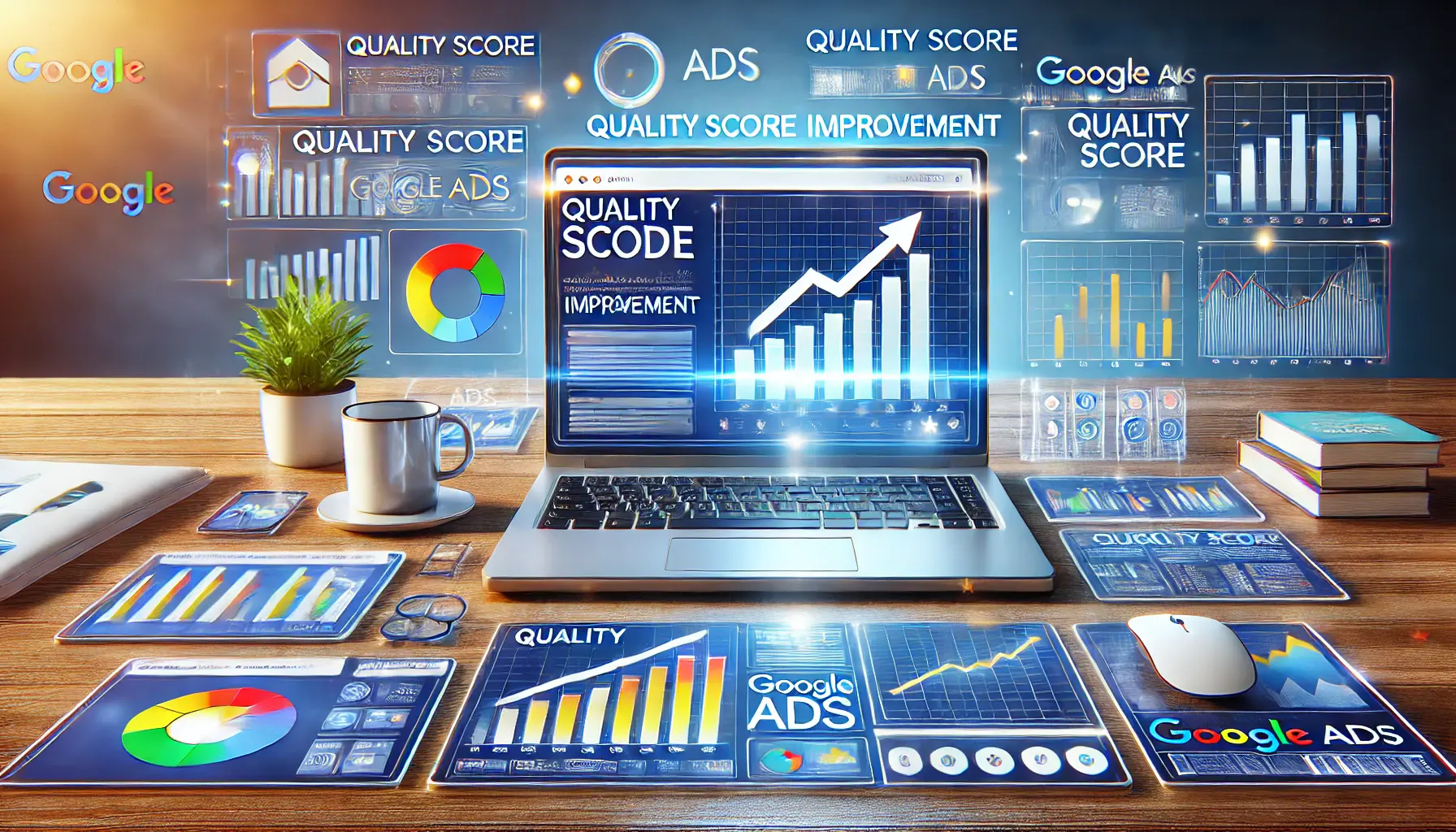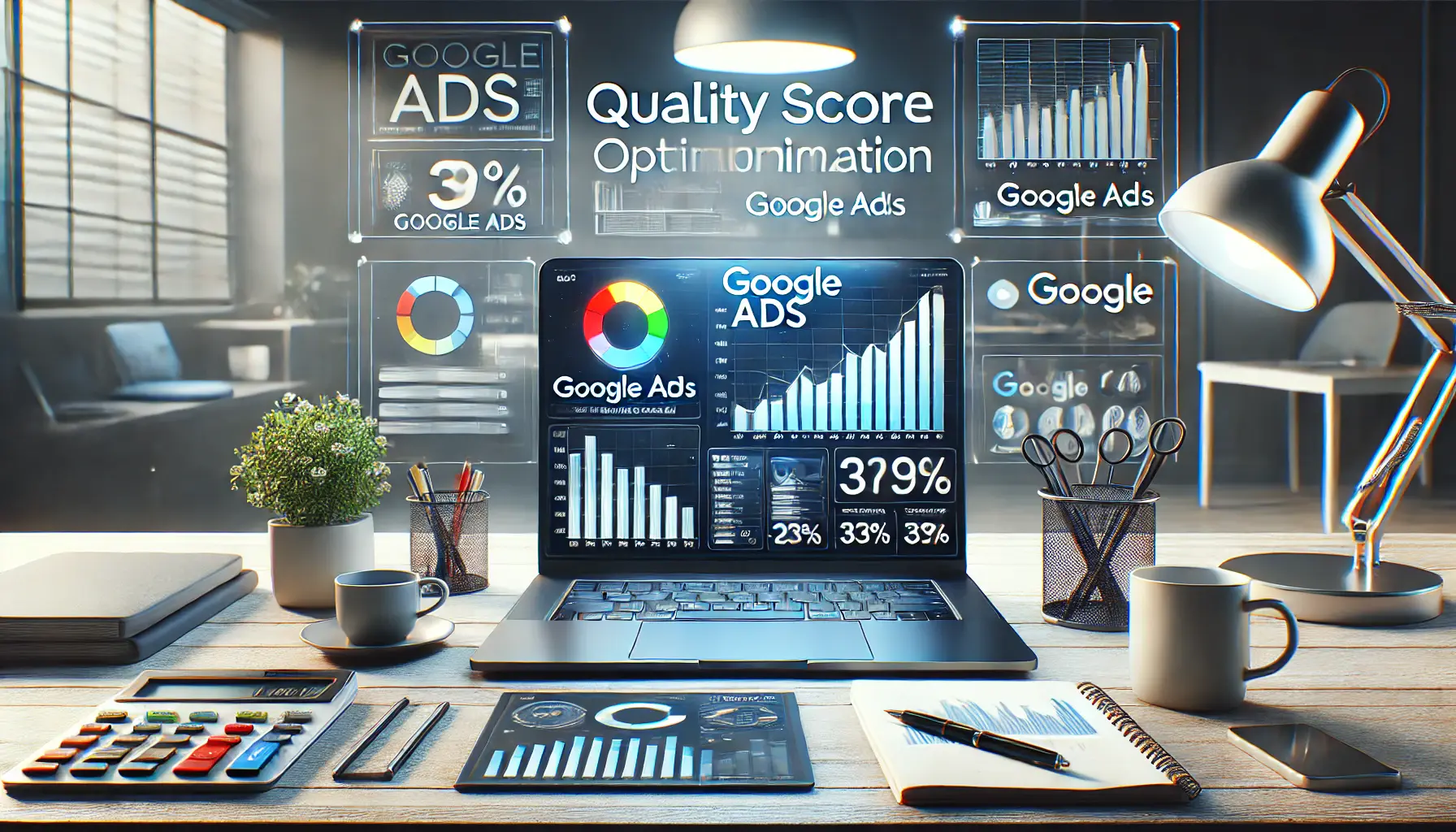Quality Score is integral in the highly competitive world of Google Ads and will determine how successful and cost-effective your ad campaigns can be.
By enhancing your Quality ScoreA metric in Google Ads that measures ad relevance, CTR, and landing page experience., you will realize better ad placements at a lower cost and, in turn, boost your campaign performance by leaps and bounds.
However, comprehending how Quality Score is determined and how it can be improved may pose a challenging task for many advertisers.
In this article, learn actionable strategies and insights to help raise your Quality Score and give you the best return on investment in Google Ads.
No matter if you’re a seasoned marketer or just starting off with Google Ads, there’s one thing you must know: how Quality Score impacts your campaigns.
This article discusses important points about Quality Score, ranging from explaining the elements that comprise the score to applying certain enhancements in ad relevance, click-through rate, and landing pageThe webpage users land on after clicking an ad, often optimized for conversions. experience.
Great, let’s dive into how you can optimize your Quality Score to better make the most of your advertising dollars and drive real campaign performance.
- Understanding Quality Score and Its Impact on Google Ads
- How to Optimize Ad Relevance for the Best Quality Score
- Click-Through Rate (CTR) Optimization to Improve Quality Score
- Optimization of Landing Pages for Quality Score Improvement
- Measuring and Tracking Quality Score Improvements
- How to Improve Quality Score in Google Ads: A Complete Guide
- Questions about Quality Score Improvement in Google Ads
Understanding Quality Score and Its Impact on Google Ads
Quality Score is a diagnostic tool in Google Ads that gives you a sense of how well your ads, keywords, and landing pages are relevant and of high quality.
This score is Google’s way of determining which ads offer the best user experience that can meet the needs of searchers best.
It’s rated from 1 to 10, with the highest being 10, and directly influences your ad rankA position indicator for ads on the search results page based on Quality Score and bid amount. and the cost per click.
A higher Quality Score can mean a higher ad position at a lower cost, whereas a low Quality Score can mean higher costs and reduced visibility.
The underlying basis for Quality Score rests on three major components: Click-Through Rate (CTRClick-through rate, the percentage of users who click on an ad after seeing it.), Ad Relevance, and Landing Page Experience.
These combined factors help Google decide the overall quality ranking of an ad.
By improving each of those areas, you will positively affect your Quality Score and thereby improve your ad performance.
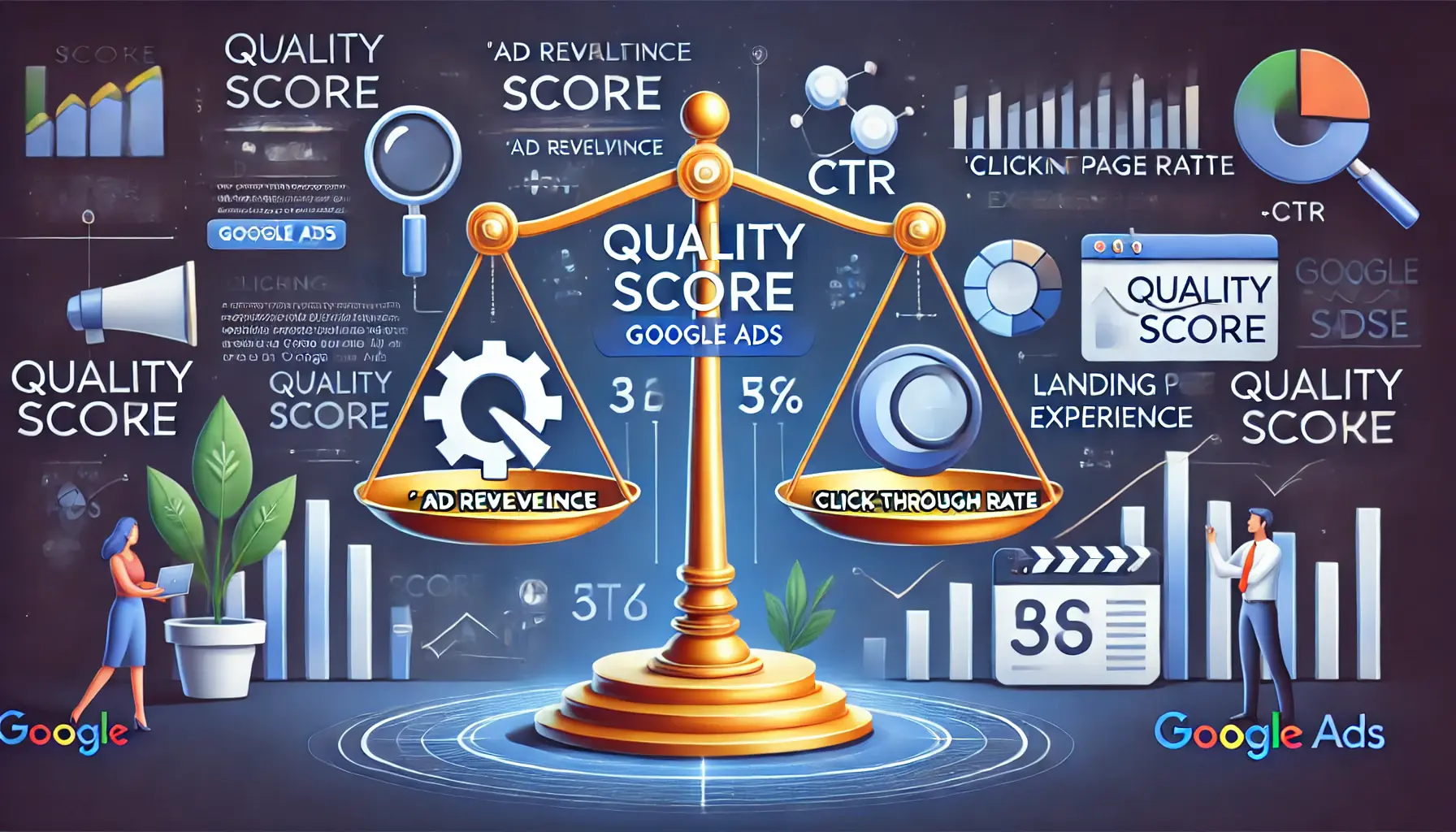
Visual representation of Quality Score and its significance in Google Ads.
What is Quality Score and Why It Matters
Quality Score may sound like just another metric, but it is one of the most influential aspects of your Google Ads performance.
It determines how much you pay per click and where your ad ranks on the search results page.
Put differently, a high Quality Score decreases your cost while increasing your ad rank; hence, advertisers will achieve the best ROI.
Consider Quality Score to be Google’s way of rewarding advertisers who make relevant, high-quality ads.
When your ad serves the users’ needs effectively, you are likely to achieve a better Quality Score.
This score can have a lasting impact on your entire advertising strategy, allowing you to reduce your ad spend while reaching more of your target audience.
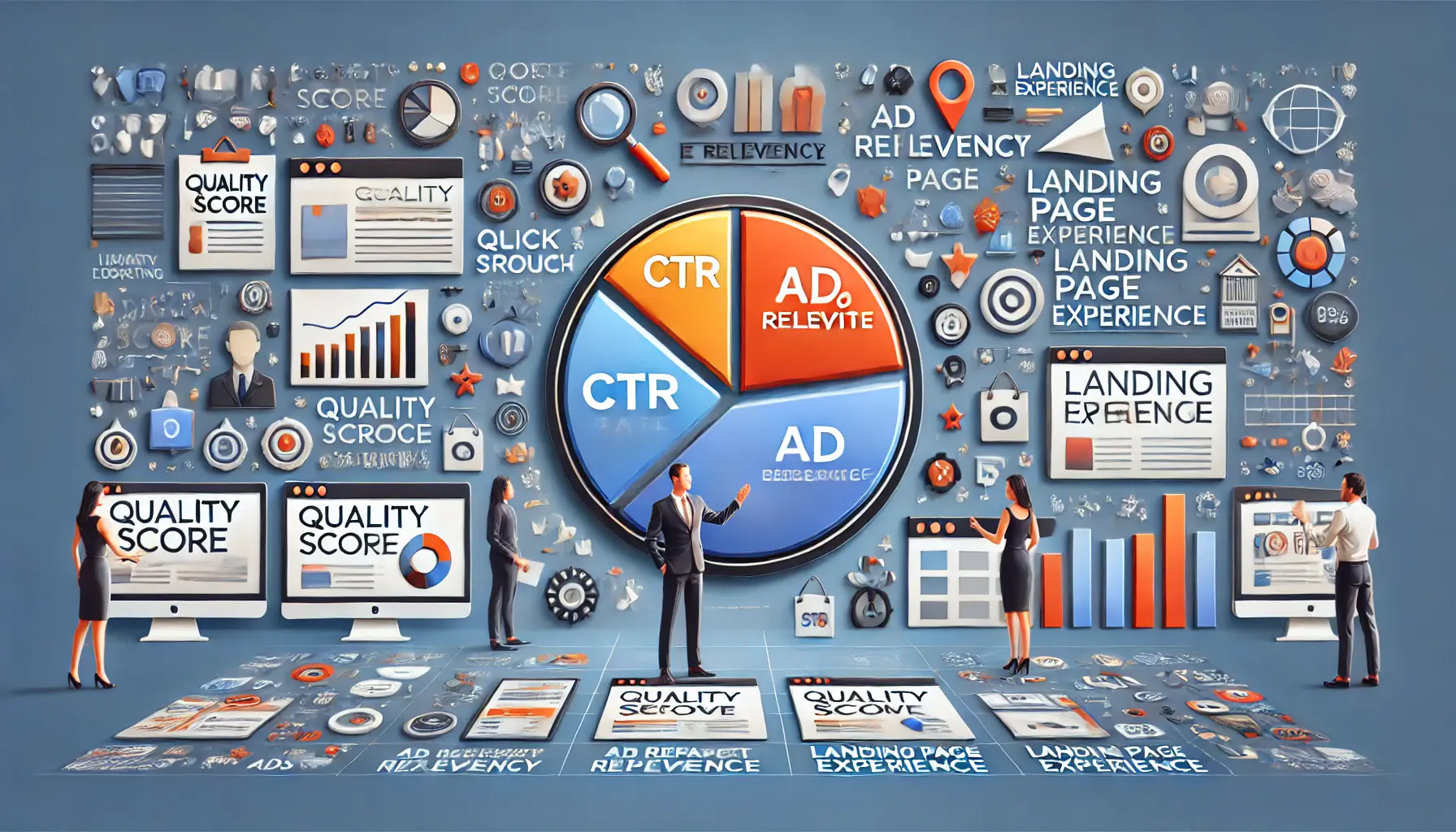
Visual representation of the core components of Quality Score in Google Ads.
Components of Quality Score: CTR, Ad Relevance, and Landing Page Experience
The three core components of Quality Score are interconnected, each playing a unique role in how Google evaluates the quality of your ads.
Here’s a breakdown of each component:
- Click-Through Rate (CTR): CTR is the rate at which people click on your ad after seeing it. A high CTR is indicative that users are finding your ad relevant, which gives you a better Quality Score. Google places significant weight on CTR because it reflects the ad’s appeal to users.
- Ad Relevance: This component measures how closely your ad matches the searcher’s intent and the keywords in your campaign. Ads that are directly relevant to what users are looking for receive a better relevance score, helping increase Quality Score.
- Landing Page Experience: Google assesses how well your landing page meets the user’s expectations after clicking your ad. A relevant, well-designed, and fast-loading landing page can significantly contribute to an improved Quality Score.
Improving each of these components can have a direct, positive effect on your Quality Score, making it a critical area to focus on in your Google Ads strategy.
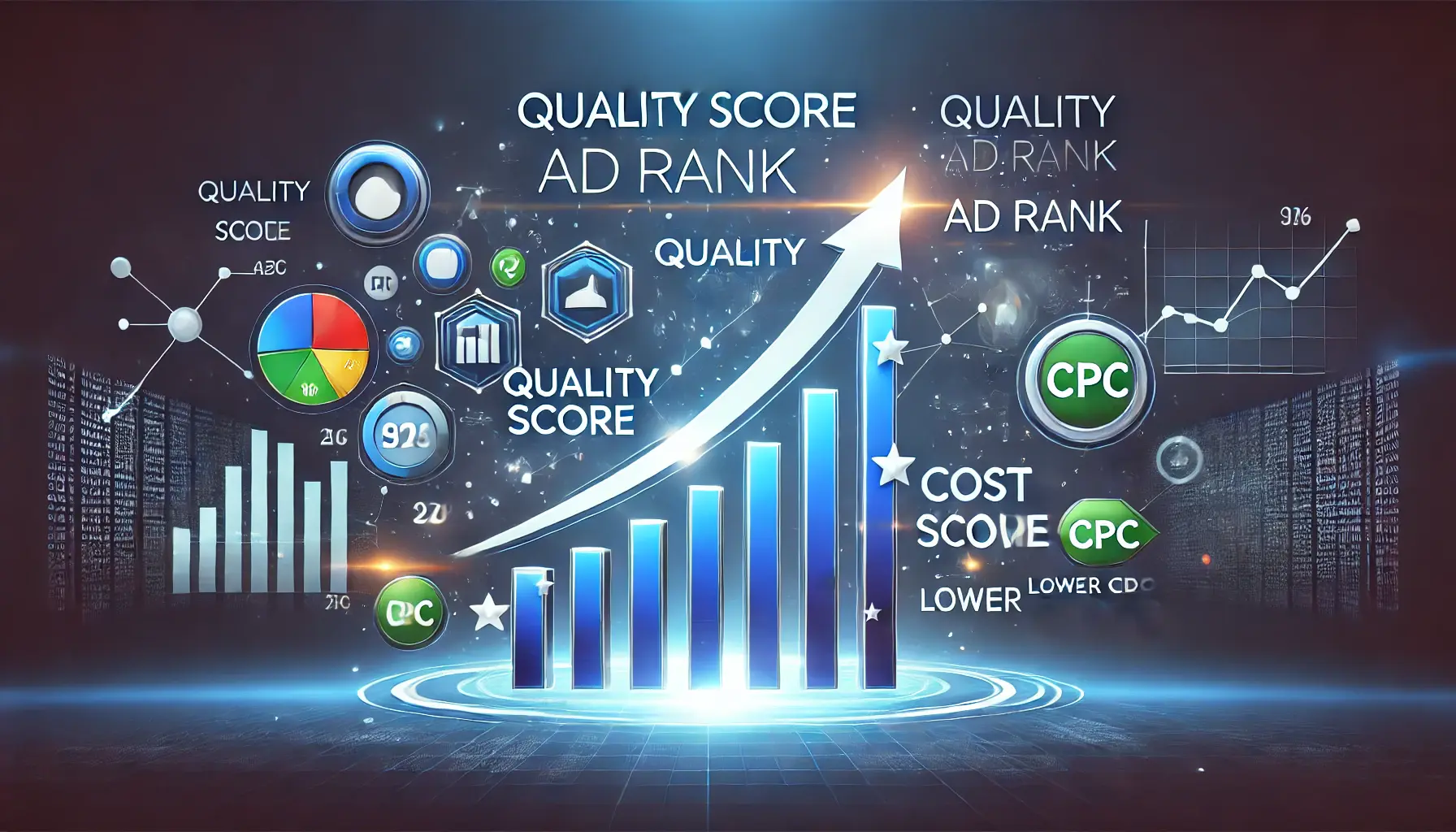
Visual representation of how Quality Score influences Ad Rank and CPC.
How Quality Score Affects Your Ad Rank and CPC
Your ad rank determines where your ad appears on the search results page, and Quality Score plays a big part in this process.
Google calculates your ad rank by multiplying your Quality Score by your bid amount.
This means that even if another competitor bids more than you in any auction, a high Quality Score can attain an ad position that is better than that of your competitor.
This ranking system favors advertisers who consistently deliver relevant, high-quality ads.
Your Quality Score also affects your cost per click (CPCCost per click, the amount charged each time a user clicks an ad.).
A higher Quality Score typically results in a lower CPC, allowing you to maximize your advertising budget.
By focusing on Quality Score improvement, you can potentially reduce ad costs while still reaching your target audience effectively.
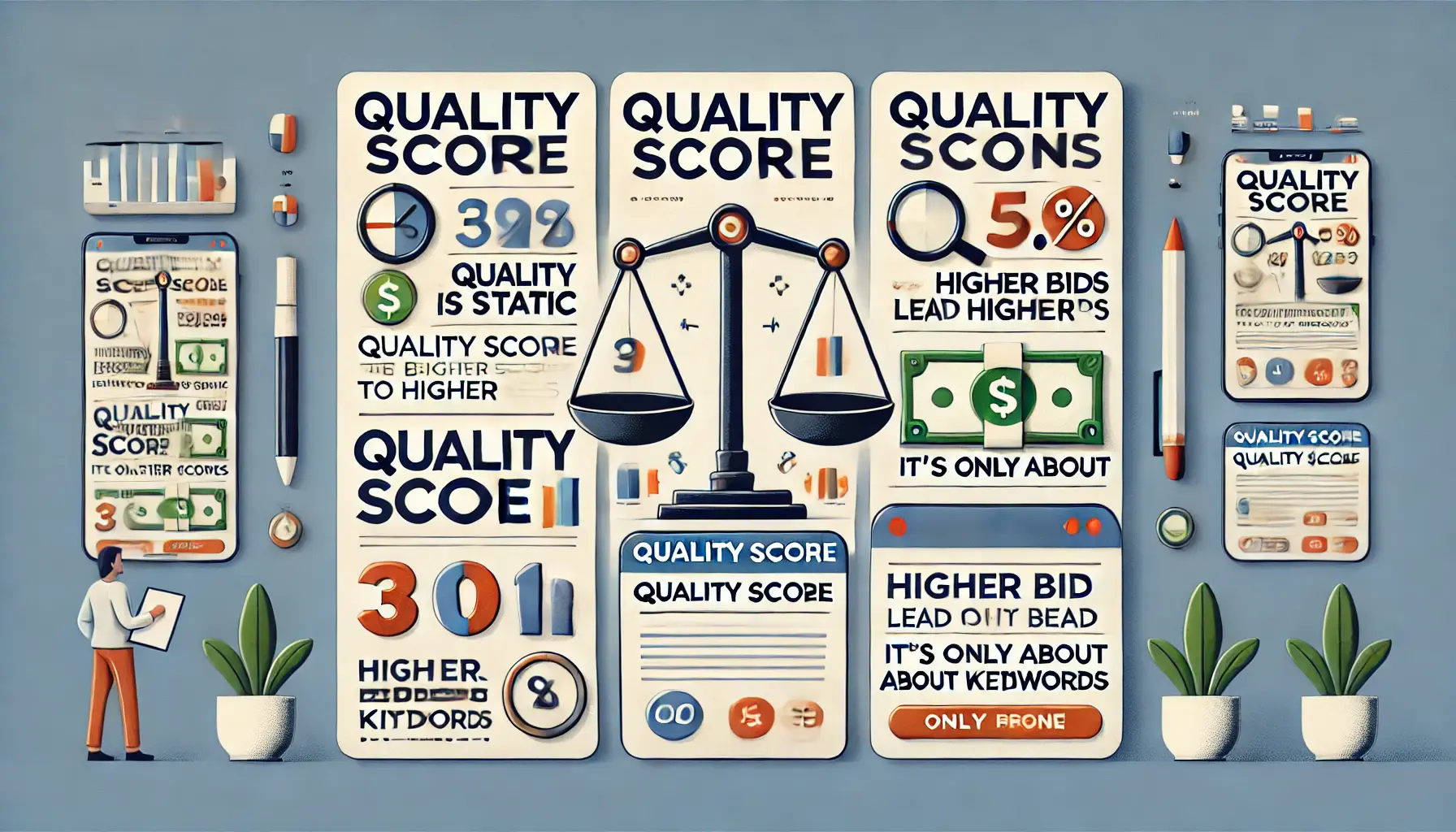
Visual representation of misconceptions about Quality Score.
Common Misconceptions About Quality Score
Many advertisers misunderstand Quality Score, leading to ineffective strategies and wasted budgets.
Here are some common misconceptions:
- Quality Score Isn’t Static: It’s a dynamic score that changes based on user behavior, keyword trends, and your ad’s relevance. Regular optimization is key to maintaining an optimum Quality Score.
- Higher Bids Don’t Always Lead to Higher Quality Scores: While bid amount influences ad rank, Quality Score is based on the ad’s quality and relevance, not the bid alone.
- Landing Page Isn’t All About Keywords: While relevant keywords help, Google also looks at user experience factors like load speed, design, and content relevance on the landing page.
Understanding these components and misconceptions can give you a more accurate perspective on Quality Score, helping you refine your Google Ads campaigns for maximum performance.
Quality Score directly affects your ad rank and cost per click, making it crucial for achieving high ad performance at a lower cost.
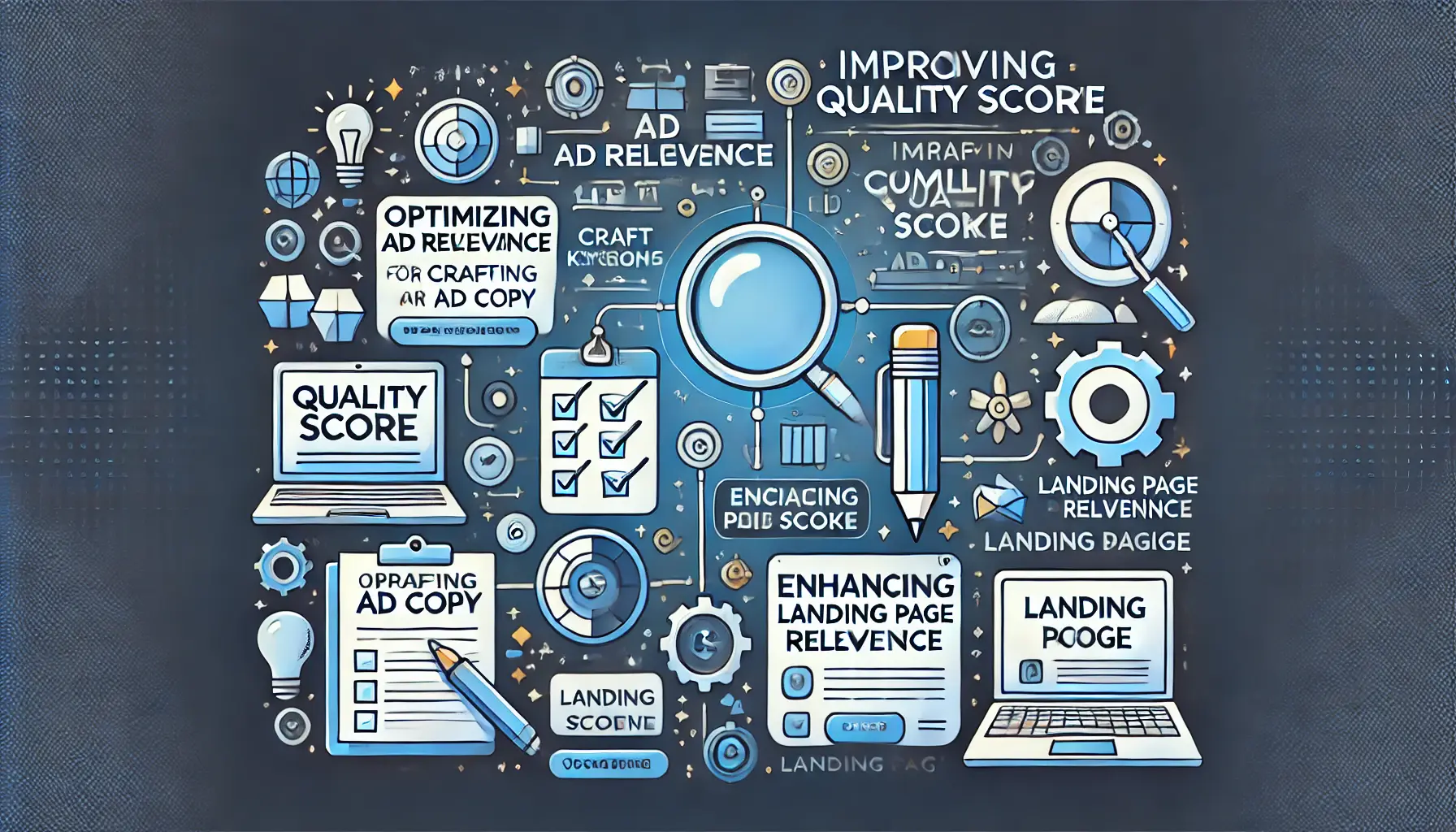
Visual representation of strategies to optimize ad relevance.
How to Optimize Ad Relevance for the Best Quality Score
Ad relevance is a top contributor to Quality Score, as it shows how closely your ad aligns with user intent.
The better your ad relevance, the higher your Quality Score, which can help lower costs and improve ad positions.
In Google Ads, relevance is based on how closely your keywords, ad copy, and landing page content match what the user is actually searching for.
This focus on ad relevance not only increases Quality Score but also ensures your message reaches the right audience.
Work on improving ad relevance with a few targeted strategies that create ads that resonate with potential customers.
Let’s explore some of these effective techniques.
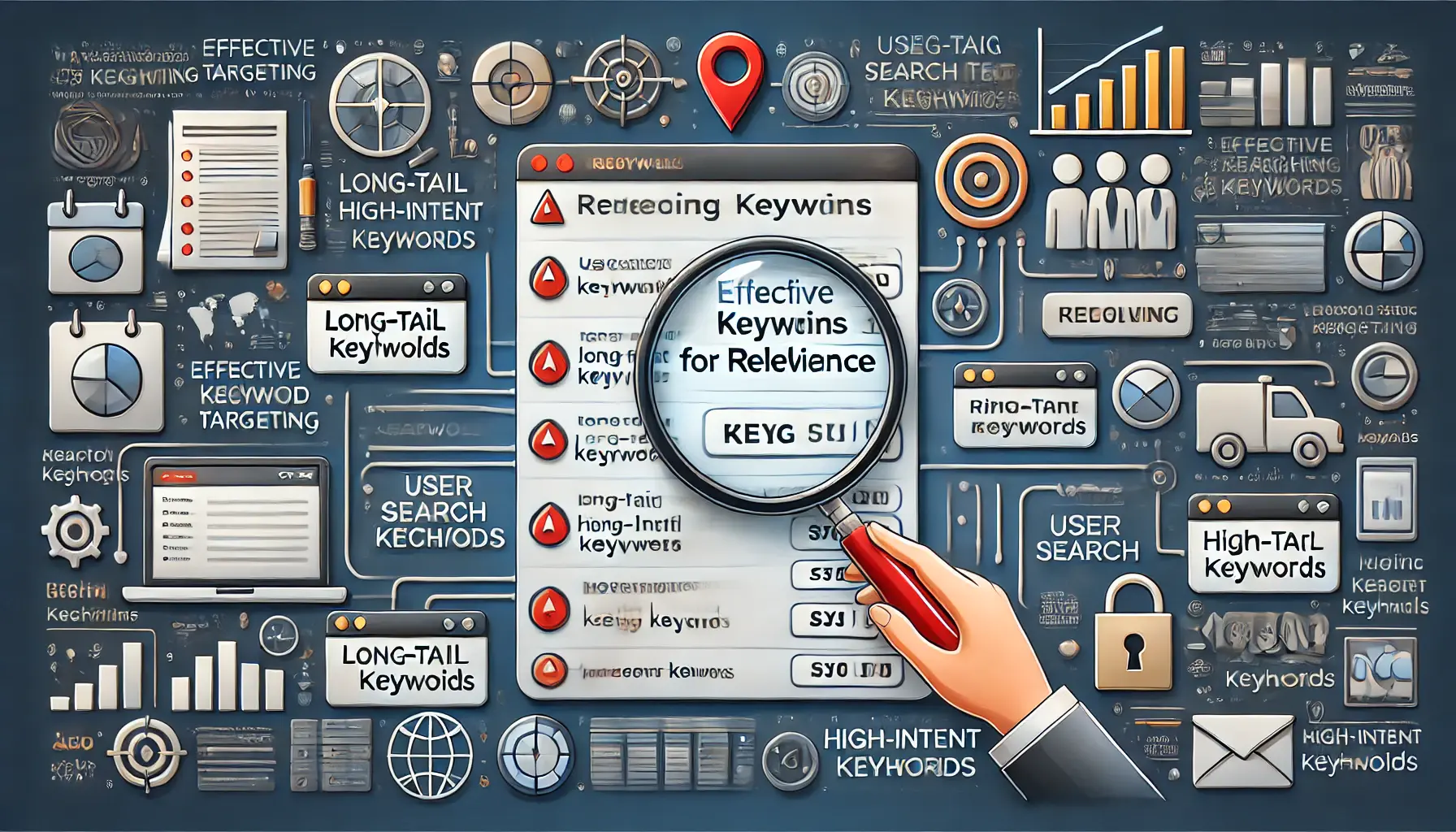
Visual representation of the importance of keyword targeting in ad relevance.
Target the Right Keywords for Relevance
Keywords form the basis of ad relevance.
By targeting the right keywords, your ad will show only to users most likely interested in what you’re offering.
To achieve better ad relevance, it’s essential to conduct thorough keyword research, identifying terms that best describe your product or service.
- Keyword Intent: Look for high-intent keywords, such as phrases that indicate a user is ready to buy or make a decision.
- Long-Tail and Specific Keywords: Use long-tail keywords rather than broad terms. Long-tail keywords have less competition and attract users with a more specific intent.
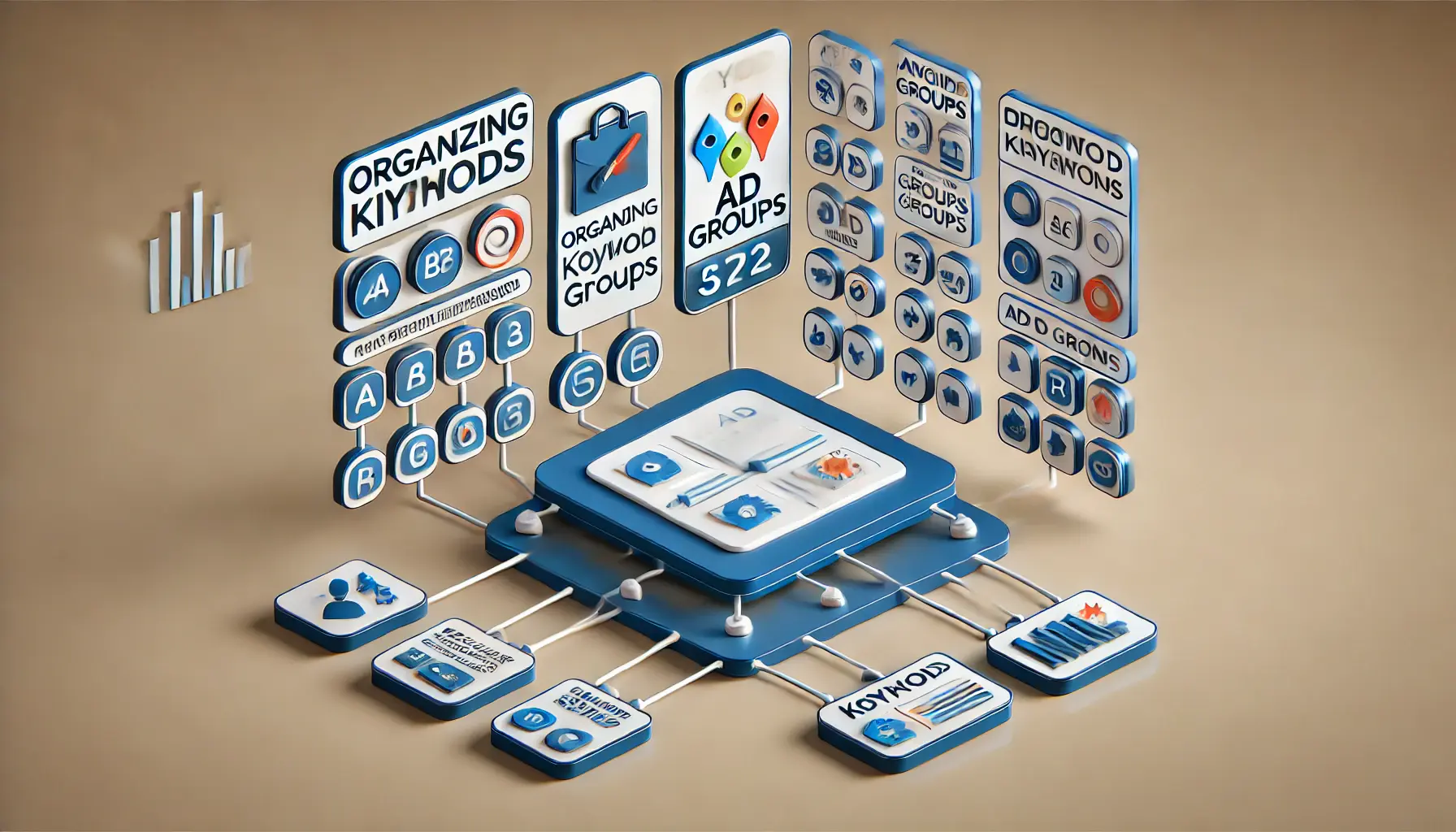
Visual representation of the importance of organizing keywords into ad groups.
Organize Keywords into Ad Groups
Group similar keywords into dedicated ad groups, which will make your ads more relevant to each keyword set.
This allows you to tailor ad copy for each group, increasing both relevance and Quality Score.

Visual representation of the importance of regularly updating your keyword list.
Refresh Your Keyword List Regularly
Continuously update your keyword list by adding new terms using tools like Google Keyword PlannerA tool provided by Google to help advertisers find relevant keywords. and removing underperforming keywords.
Regularly refining your keyword list helps sustain ad relevance over time.
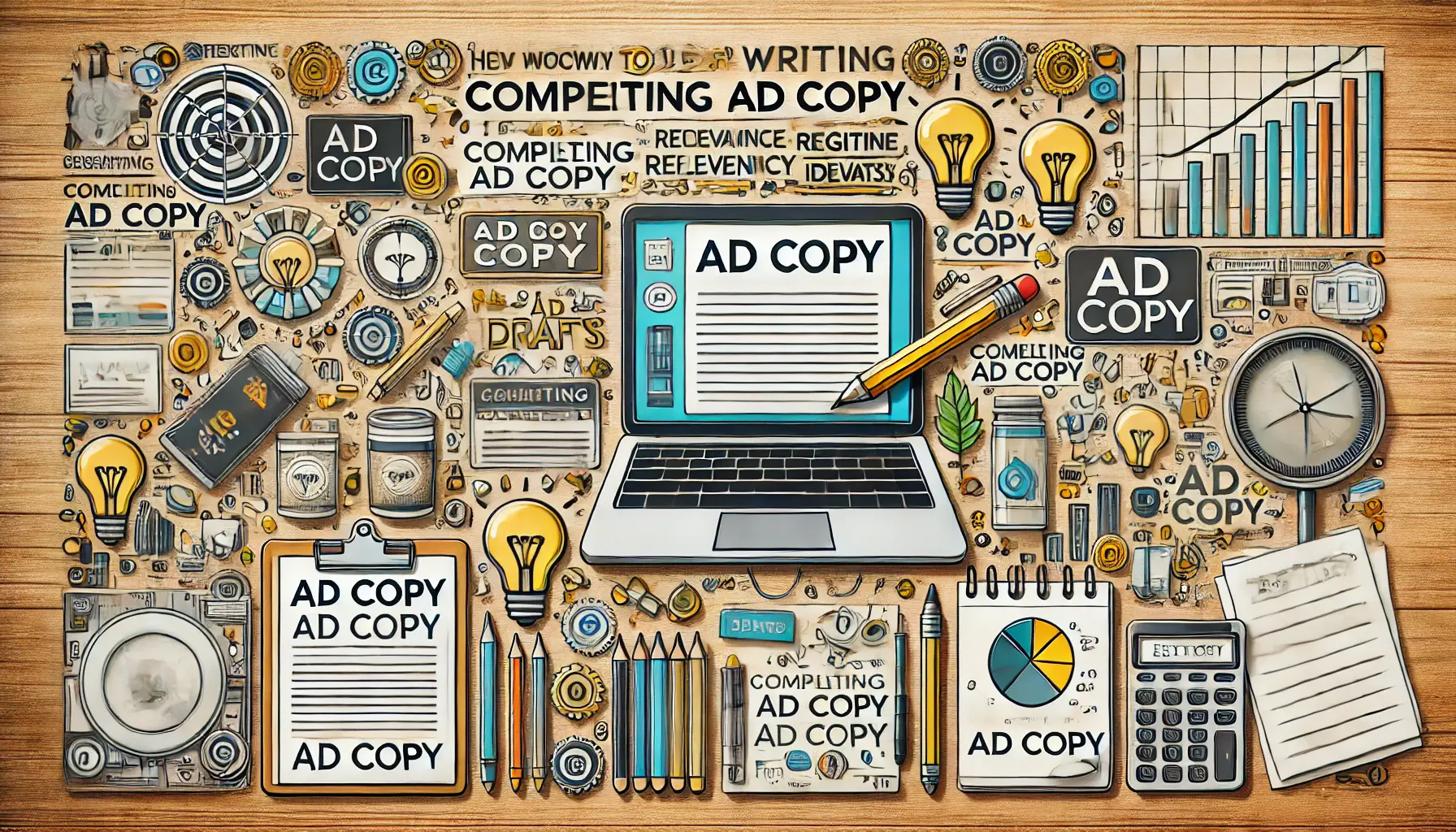
Visual representation of the process of crafting engaging ad copy.
Writing Compelling Ad Copy for More Relevance
Ad copy plays a critical role in relevance.
When the ad text closely aligns with keywords and search queries, your ad becomes highly relevant to what users are searching for.
This can increase engagement and improve click-through rate (CTR), which in turn boosts Quality Score.
- Include Primary Keywords in Headlines: Use main keywords in ad headlines to catch the user’s attention and improve CTR.
- Focus on User Benefits: Highlight the unique benefits of your product or service to show users the value they’ll gain. Benefit-focused ads often achieve higher engagement rates.
- Test and Optimize Ad Variations: Conduct A/B tests to identify the most effective ad copy. Regular testing and optimization help maintain high ad relevance.
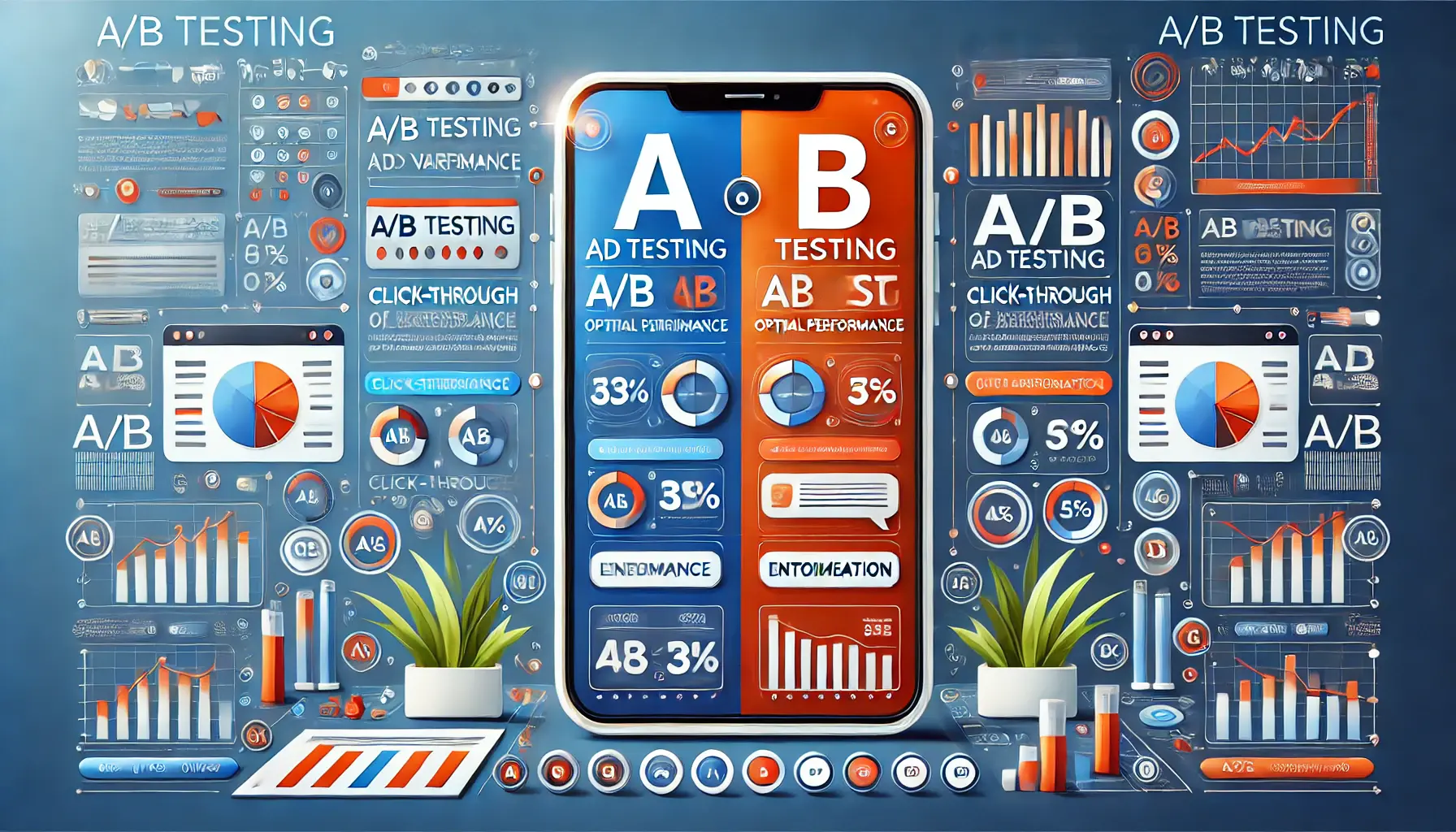
Visual representation of A/B testing in digital advertising.
A/B Testing Ad Variations for Optimal Performance
A/B testing allows you to test different ad versions to see which resonates best with your audience.
By testing variations in ad headlines, descriptions, and calls-to-action, you can identify the copy that enhances relevance and Quality Score.
- Experiment with Headlines and Descriptions: Test different combinations of headlines and descriptions that incorporate keywords and align with user intent.
- Monitor Key Performance Metrics: Track CTR, conversion rate, and Quality Score to identify top-performing ads. Adjust ads based on results to optimize relevance continually.
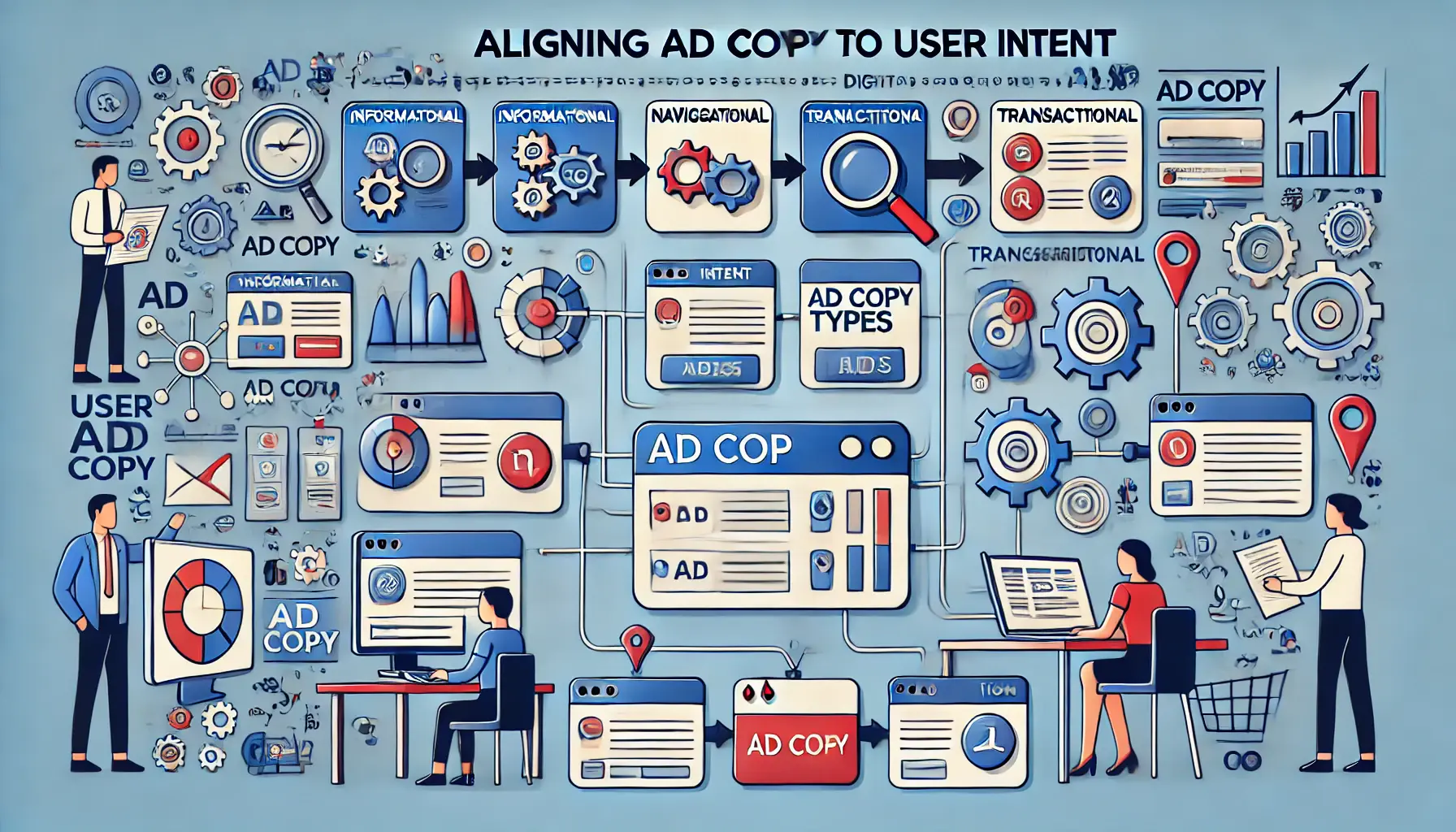
Visual representation of the importance of matching ad copy to user intent.
Align Ad Copy to User Intent
Understanding user intent and tailoring ad content to match that intent is essential for achieving high ad relevance.
Aligning ad copy with what users are looking for enhances engagement and increases the chances of achieving a higher Quality Score.
- Identify User Intent Types: Determine if the intent is informational, navigational, or transactional, and adjust ad content to reflect this intent.
- Use Clear Calls-to-Action: Guide users to take a specific action, whether it’s buying a product, signing up, or learning more. Compelling calls-to-action aligned with user intent improve both ad relevance and conversion rates.
Improving ad relevance is a continuous process that involves regular optimization of keywords, ad copy, and ad group structure.
As you create ads that closely match user expectations, you not only boost Quality Score but also foster richer engagement with potential customers.
Improving ad relevance is a top priority for boosting Quality Score and ensuring your ads align with what users are actively searching for.

Visual representation of the importance of CTR optimization in digital advertising.
Click-Through Rate (CTR) Optimization to Improve Quality Score
CTR is a serious determinant of Quality Score in Google Ads.
The higher the CTR, the more appealing and relevant your ad appears to users, which directly contributes to a better Quality Score.
Working to improve CTR will not only help increase your Quality Score but also enhance ad efficiency by driving more clicks and conversions.
In this section, we’ll discuss effective strategies to boost CTR and, as a result, enhance your Quality Score.
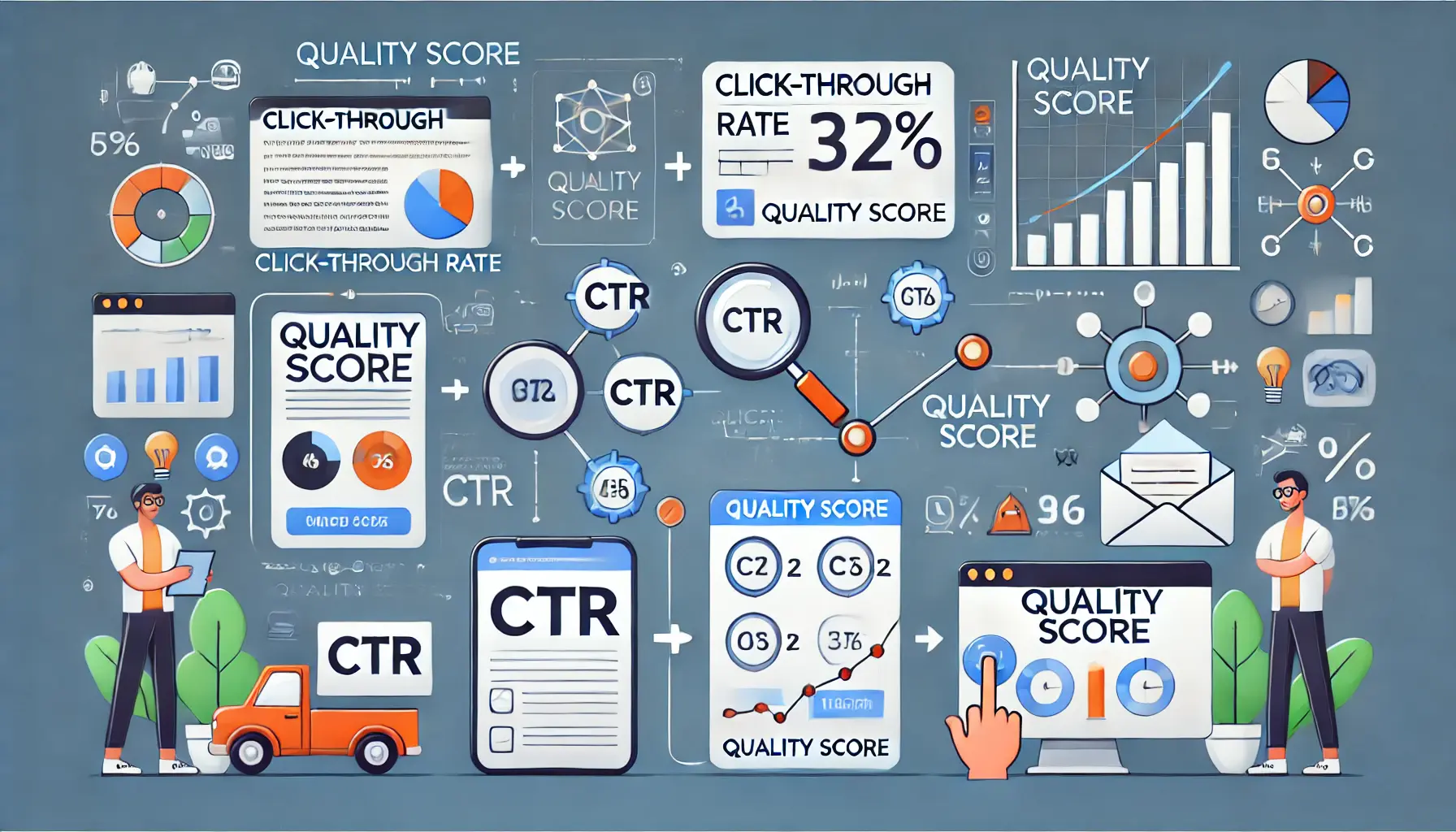
Visual representation of how CTR impacts Quality Score.
The Role of CTR in Quality Score Calculation
CTR reflects how often users click on your ad compared to how often it is shown.
Google views CTR as a strong indicator of relevance; a high CTR suggests that your ad aligns closely with user intent.
The higher the CTR, the better your chance of Google rewarding you with an improved Quality Score, which can lower your cost per click (CPC) and improve ad position.
Improving CTR involves understanding your audience and crafting ad content that meets their needs and interests.
Let’s explore a few methods to achieve this.

Visual representation of tips for crafting engaging ad headlines.
Tips for Writing Click-Worthy Ad Headlines
The headline is the first thing users notice in your ad, making it essential to create an appealing, relevant headline to increase CTR.
Great headlines attract attention, pique interest, and encourage clicks.
Here are a few tactics:
- Include Keywords in the Headline: Organically use primary keywords in your headline. This helps users recognize the ad’s relevance to their search query.
- Highlight Unique Selling Points: Emphasize what differentiates your product, such as free shipping, exclusive discounts, or unique features.
- Create a Sense of Urgency: Phrases like “Limited Time Offer” or “Only a Few Left” can encourage users to click now rather than miss out.

Visual representation of ad extensions enhancing CTR in digital advertising.
Using Ad Extensions to Improve CTR
Ad extensions are a valuable feature in Google Ads, allowing you to add extra information to your ads, increasing their visibility.
Extensions can directly boost CTR by offering users more details upfront.
Here are some effective ad extensionsAdditional information or features added to Google Ads, such as links or contact details. to consider:
- Sitelink Extensions: These allow you to include links to specific pages on your website, such as product or contact pages, providing users with quick access to relevant information.
- Callout Extensions: Highlight key benefits or offers, such as “24/7 Support” or “Free Consultation,” to attract clicks.
- Structured Snippets: Provide additional details about your product or service categories, enabling users to see relevant offerings at a glance.
- Call Extensions: Add a click-to-call option to your ad, which is especially useful for mobile users who may prefer direct contact.

Visual representation of user intent types and their impact on advertising strategies.
Understanding and Optimizing for User Intent
Optimizing for user intent involves crafting your ad to align with what users are searching for.
Understanding their intent allows you to create more relevant ads, naturally boosting CTR.
Here are some tips:
- Analyze Search Intent: Determine whether the user is looking to make a purchase, find information, or navigate to a specific site. Tailor your ad copy to match this intent for a higher CTR.
- Match Ad Copy to Keywords: Include targeted keywords in your ad text to ensure relevance to the user’s search query.
- Address Pain Points: Use your ad to solve a problem or offer a solution that meets the user’s needs, increasing the likelihood of clicks.
Focus on CTR improvement strategies like optimizing headlines, using ad extensions, and aligning with user intent to achieve increased clicks, a better Quality Score, and improved performance from your Google Ads campaigns.
Boosting CTR not only improves Quality Score but also enhances ad visibility and engagement.
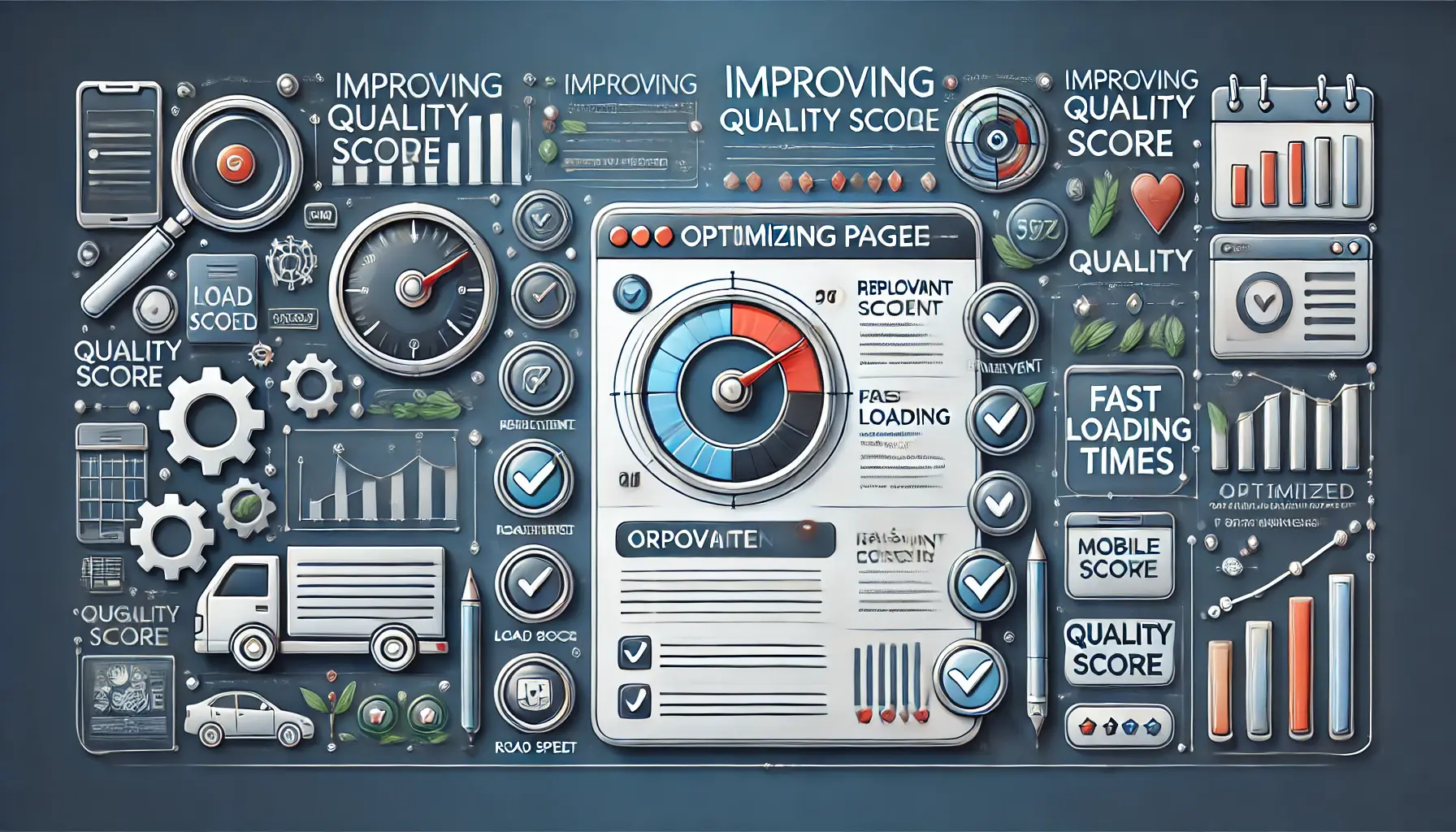
Visual representation of key elements in landing page optimization.
Optimization of Landing Pages for Quality Score Improvement
Landing page experience plays a significant role in determining Quality Score, as it impacts user satisfaction and relevance after clicking on an ad.
Google favors ads that lead users to high-quality, relevant landing pages, creating opportunities for Quality Score improvement and a reduction in cost per click.
An optimized landing page can enhance both Quality Score and conversion rates by ensuring that users encounter a seamless, highly relevant experience.
This section will cover essential strategies to optimize your landing page for a higher Quality Score.
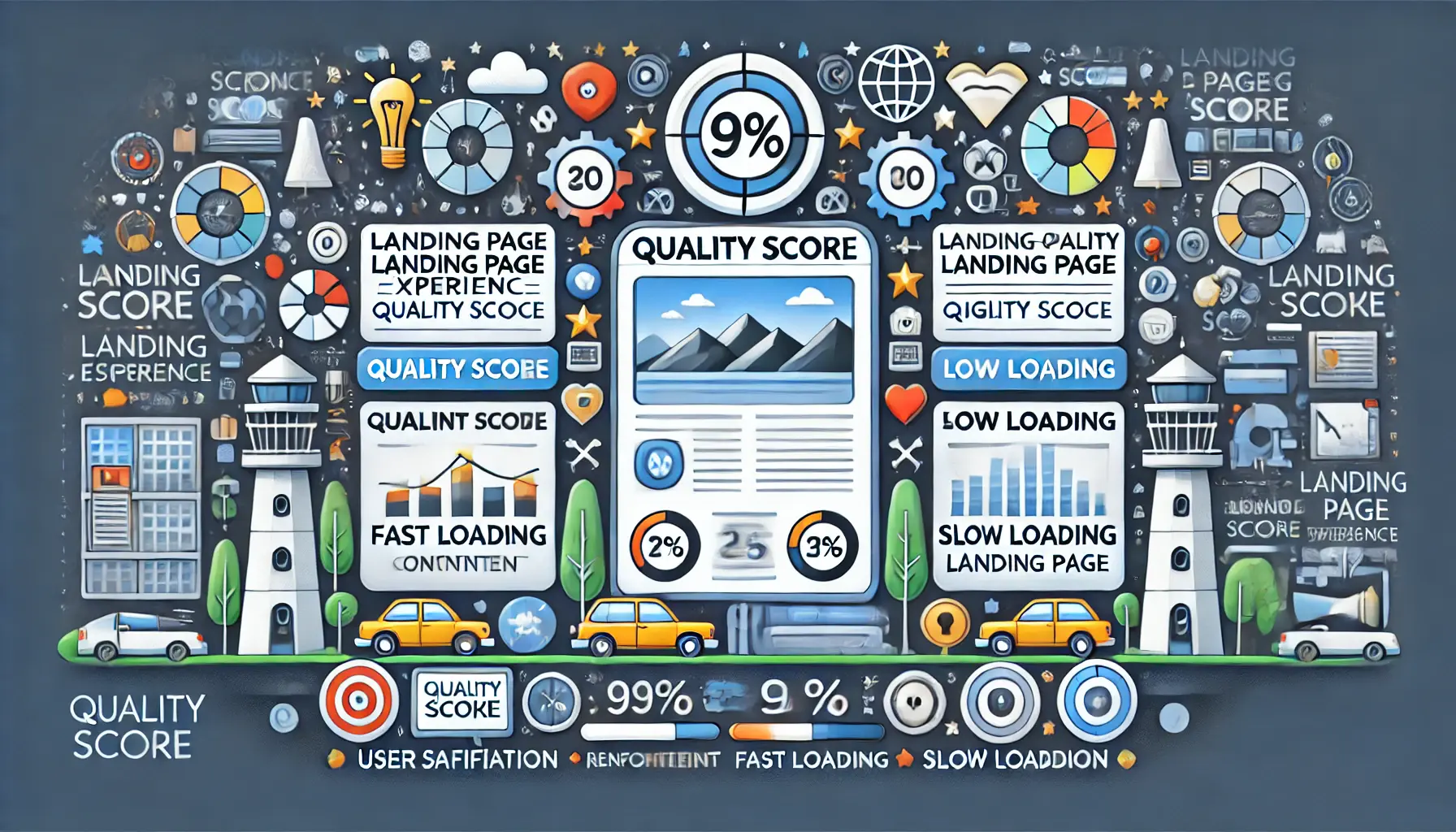
Visual representation of the impact of landing page experience on Quality Score.
Importance of Landing Page Experience in Quality Score
Google evaluates landing page experience based on relevance, transparency, ease of navigation, and loading speed.
A positive landing page experience signals to Google that your ad is relevant and useful, resulting in a higher Quality Score.
Important factors contributing to a good landing page experience include fast loading times, mobile-friendlinessThe ease of use and accessibility of a webpage on mobile devices., and relevant content.
Here are a few factors to consider when optimizing landing page experience:
- Relevance: Ensure the content on your landing page matches the ad copy and keywords. The page should fulfill the expectations set by the ad, helping users find exactly what they anticipated.
- Transparency: Be clear about your offerings and avoid misleading information. Users should understand exactly what they’ll receive upon clicking your ad.
- Navigation: A clean, user-friendly layout enhances usability, keeps users engaged longer, and reduces bounce rates, all of which improve Quality Score.
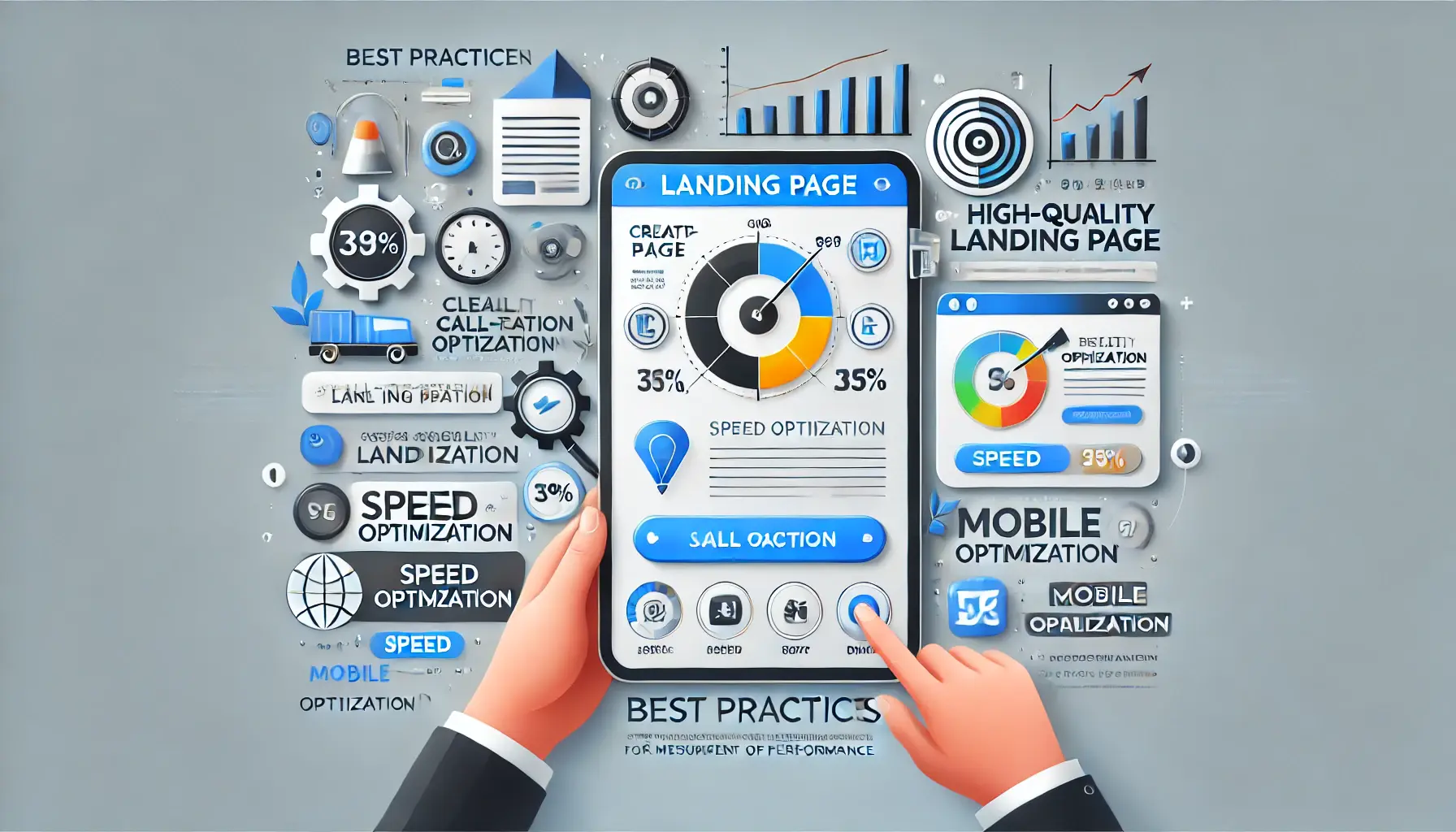
Visual representation of key elements for creating a high-quality landing page.
Best Practices for a High-Quality Landing Page
Applying best practices in landing page design can positively impact both Quality Score and conversions.
Here are some effective techniques for creating a high-quality landing page:
- Maintain Visual Continuity: Ensure that the design of your landing page aligns with the ad’s visuals and branding, providing a cohesive user experience.
- Optimize for Mobile: Many users view ads on mobile devices, so make sure your landing page is mobile-friendly and easy to navigate on smaller screens.
- Use Clear and Compelling CTAs: Guide users with a clear call-to-action that aligns with the ad copy, prompting them to take actions like signing up or making a purchase.
- Minimize Distractions: Keep the page focused on its primary goal. Avoid unnecessary elements that might distract users from completing the desired action.
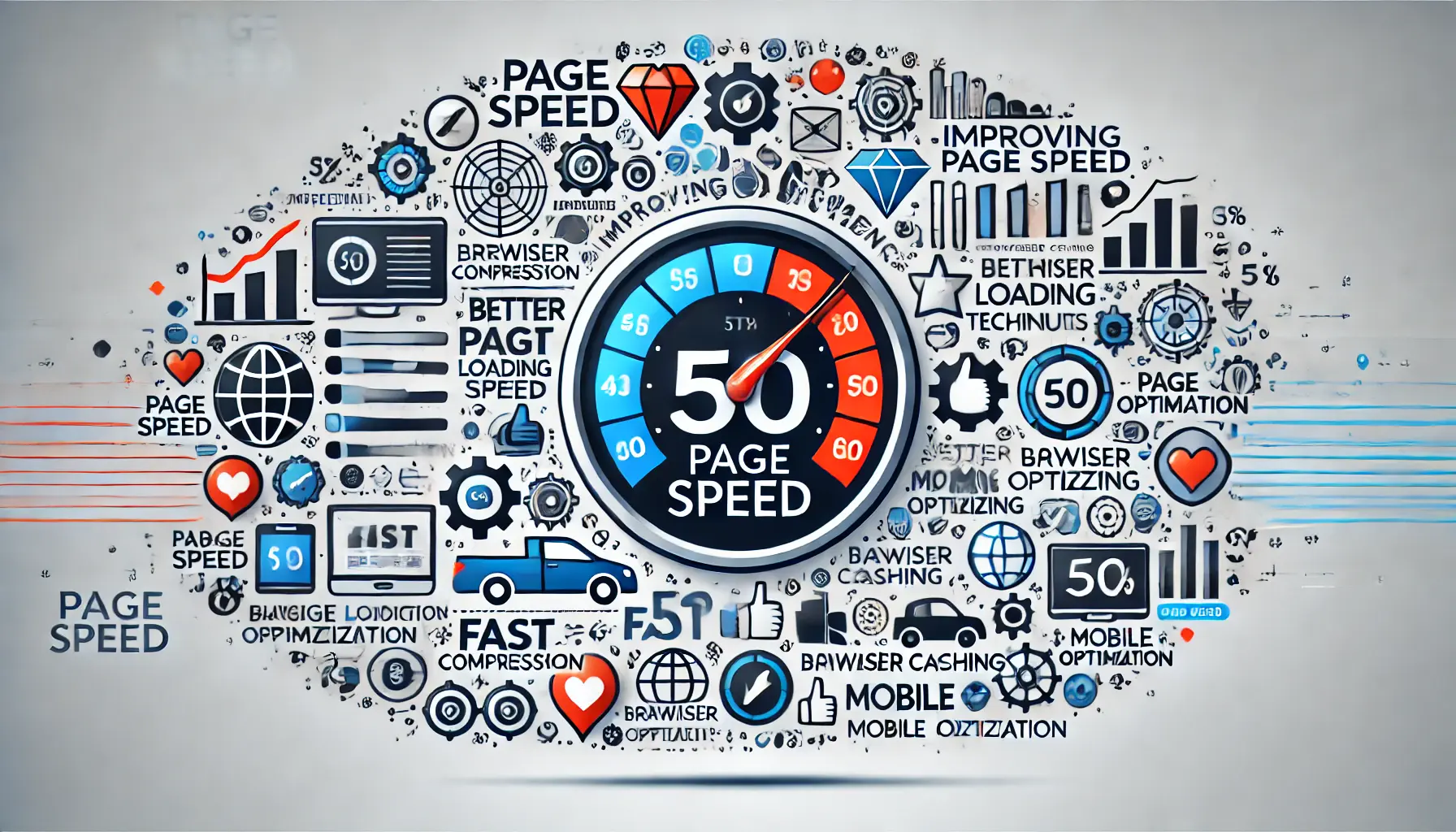
Visual representation of the importance of page speed in enhancing user experience.
Improving Page Speed for Better User Experience
Page speed is a crucial factor in landing page optimization, as it impacts both Quality Score and user engagement.
Slow-loading pages can increase bounce rates and decrease user satisfaction.
Optimizing page load times can positively influence Quality Score and conversion rates.
- Image Compression and Resizing: Compress and resize images to reduce load times without compromising quality.
- Reduce Code: Minimize code, reduce JavaScript, and implement browser caching to ensure a smooth and fast-loading experience.
- Use Accelerated Mobile Pages (AMP): Consider AMP for faster mobile loading speeds, especially for ad landing pages.
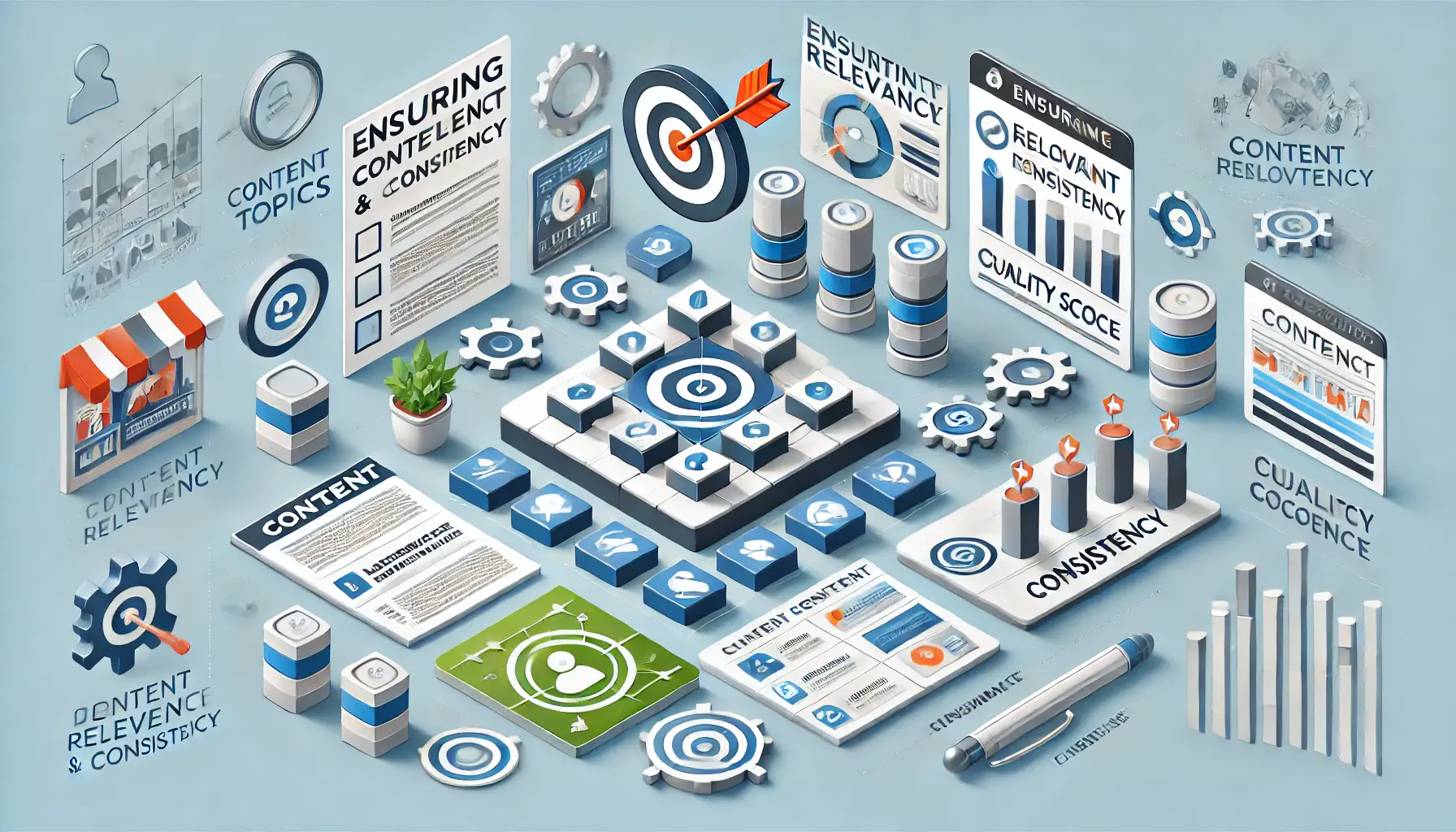
Visual representation of the importance of content relevance and consistency in digital advertising.
Ensuring Content Relevance and Consistency
Content relevance and consistency are essential for a positive landing page experience.
Your landing page should align with user intent and provide information that matches the ad copy.
- Match Ad Copy with Landing Page Content: Ensure the message on the landing page corresponds with the promises made in the ad. This consistency builds trust and encourages user engagement.
- Focus on Readability: Use simple language, clear headings, and short paragraphs to make the content easily scannable.
- Provide Value: Offer valuable information that assists users in making informed decisions. A useful, well-structured page increases engagement and helps improve Quality Score.
By focusing on landing page optimization, including relevance, speed, and mobile-friendliness, you can enhance user experience, boost Quality Score, and improve ad performance in Google Ads.
A high-quality, relevant landing page experience enhances Quality Score and drives better conversions.
Visual representation of measuring and tracking Quality Score improvements in digital advertising.
Measuring and Tracking Quality Score Improvements
To optimize your Google Ads campaigns, it’s essential to measure and track Quality Score improvements consistently.
By monitoring changes in Quality Score, you can identify what strategies are working effectively month over month, allowing you to focus on the best approaches to enhance ad relevance, CTR, and landing page experience.
Continuous tracking also enables you to make informed decisions to maintain and improve your Quality Score over time.
In this section, we’ll cover tools and strategies for measuring Quality Score and making data-driven adjustments based on insights.

Visual representation of tools for tracking Quality Score in digital advertising.
Tools to Track Quality Score Over Time
Google Ads provides several tools and reports for tracking Quality Score over time and analyzing its components.
These tools offer insights into CTR, ad relevance, and landing page experience, helping you understand how each factor impacts your overall Quality Score.
Some of the most useful tools include:
- Google Ads Quality Score Column: Enable the Quality Score column in your Google Ads dashboard to view Quality Scores for each keyword. This feature helps you quickly monitor and compare scores across your campaigns.
- Keyword Performance Report: This report provides detailed insights into individual keywords, showing Quality Score components like ad relevance, CTR, and landing page experience.
- Segment Quality Score by Device: Segment Quality Score across devices (desktop, mobile, tablet) to identify performance discrepancies and areas for improvement.
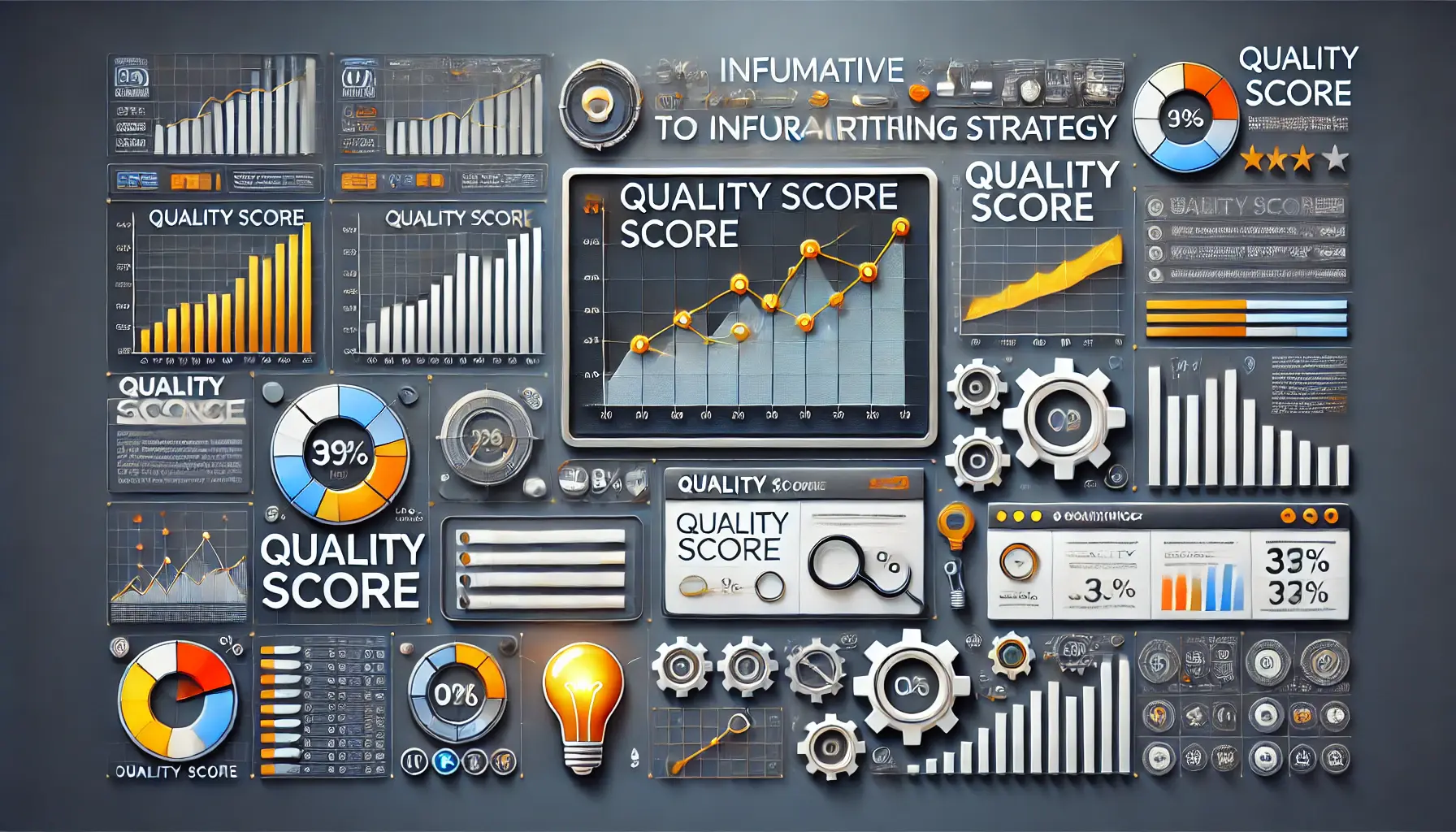
Visual representation of analyzing Quality Score changes for strategic decision-making.
Analyzing Quality Score Changes to Inform Strategy
Analyzing Quality Score components allows you to refine your ad strategy effectively.
By tracking trends and patterns in component scores, you can make adjustments that positively impact Quality Score.
Key strategies include:
- Monitor Component Scores: Regularly review the scores for ad relevance, CTR, and landing page experience. Addressing weaker areas like ad relevance or CTR can lead to significant Quality Score improvements.
- Spot Patterns and Trends: Observe Quality Score trends over time. For example, if Quality Score improves after specific adjustments, maintain those strategies to retain gains.
- Compare Quality Score Across Campaigns: Comparing Quality Scores across campaigns helps you identify successful strategies that can be applied more broadly.

Visual representation of utilizing Google Ads reports for effective campaign optimization.
Using Google Ads Reports for Performance Insights
Google Ads offers several reports that provide valuable insights into Quality Score and overall campaign performance.
Utilizing these reports can help you understand how Quality Score affects metrics like CTR, conversion rates, and CPC.
- Ad Performance Report: Use this report to assess CTR, CPC, and other key metrics related to Quality Score.
- Search Terms Report: Review the search terms users entered before clicking your ad to refine keywords and enhance ad relevance.
- Conversion Tracking: Track conversions to understand the impact of Quality Score improvements on your campaign’s bottom line and identify high-performing ads.

Visual representation of optimizing bids and budgets using Quality Score metrics.
Adjusting Bids and Budget Based on Quality Score Metrics
Higher Quality Scores can reduce CPC, enabling you to reallocate your budget to high-performing keywords.
Here are some strategic tips for bid and budget adjustments:
- Increase Bids for High-Quality Keywords: Raise bids on keywords with high Quality Scores, as they typically provide strong ROI at lower CPCs.
- Cut Spending on Low-Quality Keywords: Reduce or pause bids on low-Quality Score keywords to minimize costs on underperforming terms.
- Reallocate Savings: Use budget saved from lower CPCs to target new keywords with potential for high Quality Scores or to expand campaign efforts.
Measuring and tracking Quality Score improvements allows for informed adjustments that enhance campaign effectiveness.
By leveraging tools, reports, and strategic bid adjustments, you can optimize your Google Ads campaigns for long-term success.
Regular tracking of Quality Score and its components enables targeted improvements, helping you maintain optimal ad performance.
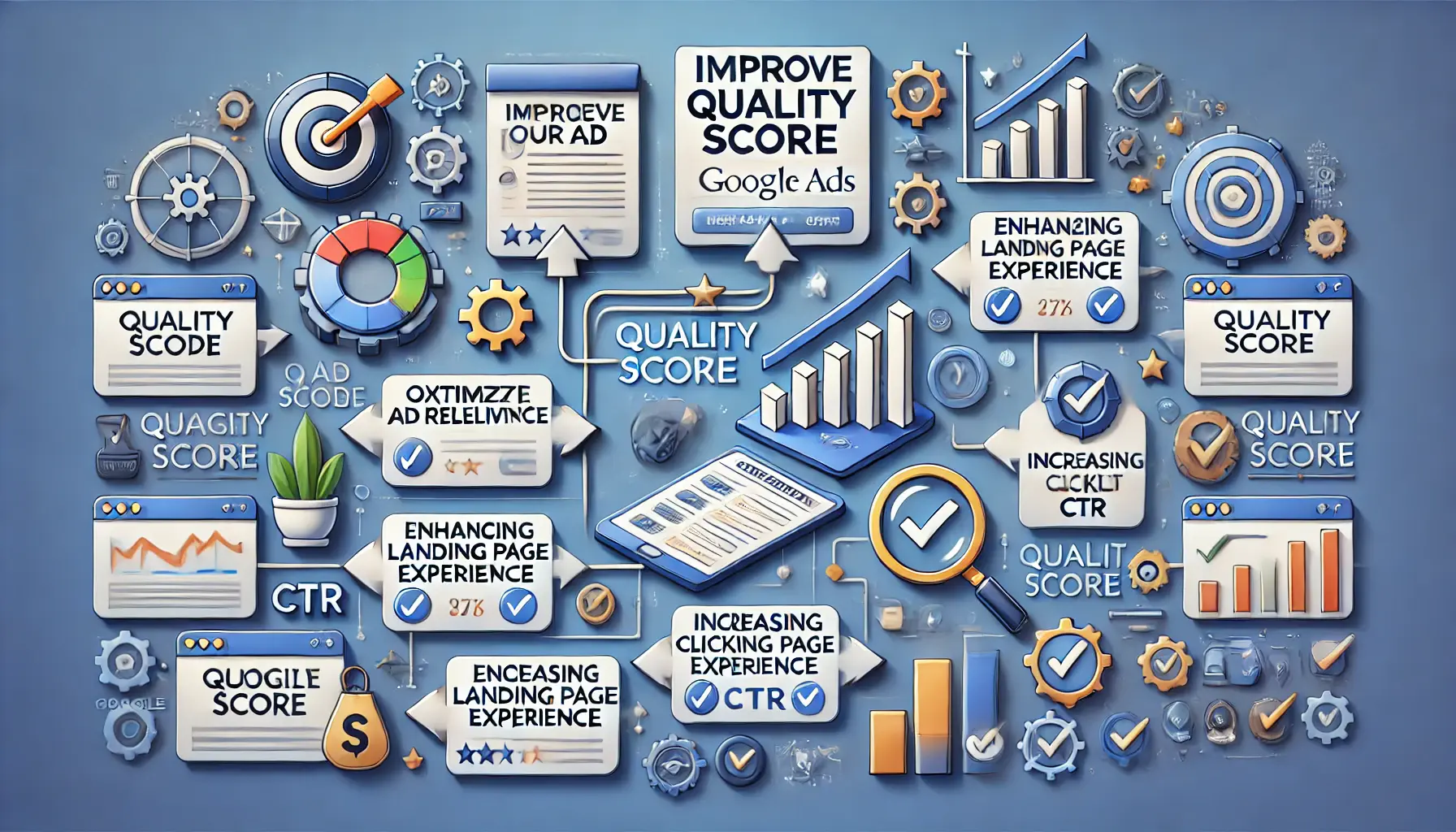
Visual representation of strategies to enhance Quality Score in Google Ads.
How to Improve Quality Score in Google Ads: A Complete Guide
Improving Quality Score in Google Ads involves multiple strategies for enhancing ad performance, reducing costs, and driving better results for your campaigns.
This article has covered essential aspects of Quality Score—from understanding its components to implementing targeted improvement strategies.
Below, we’ll summarize some key takeaways and best practices to help you maintain and improve Quality Score over time.
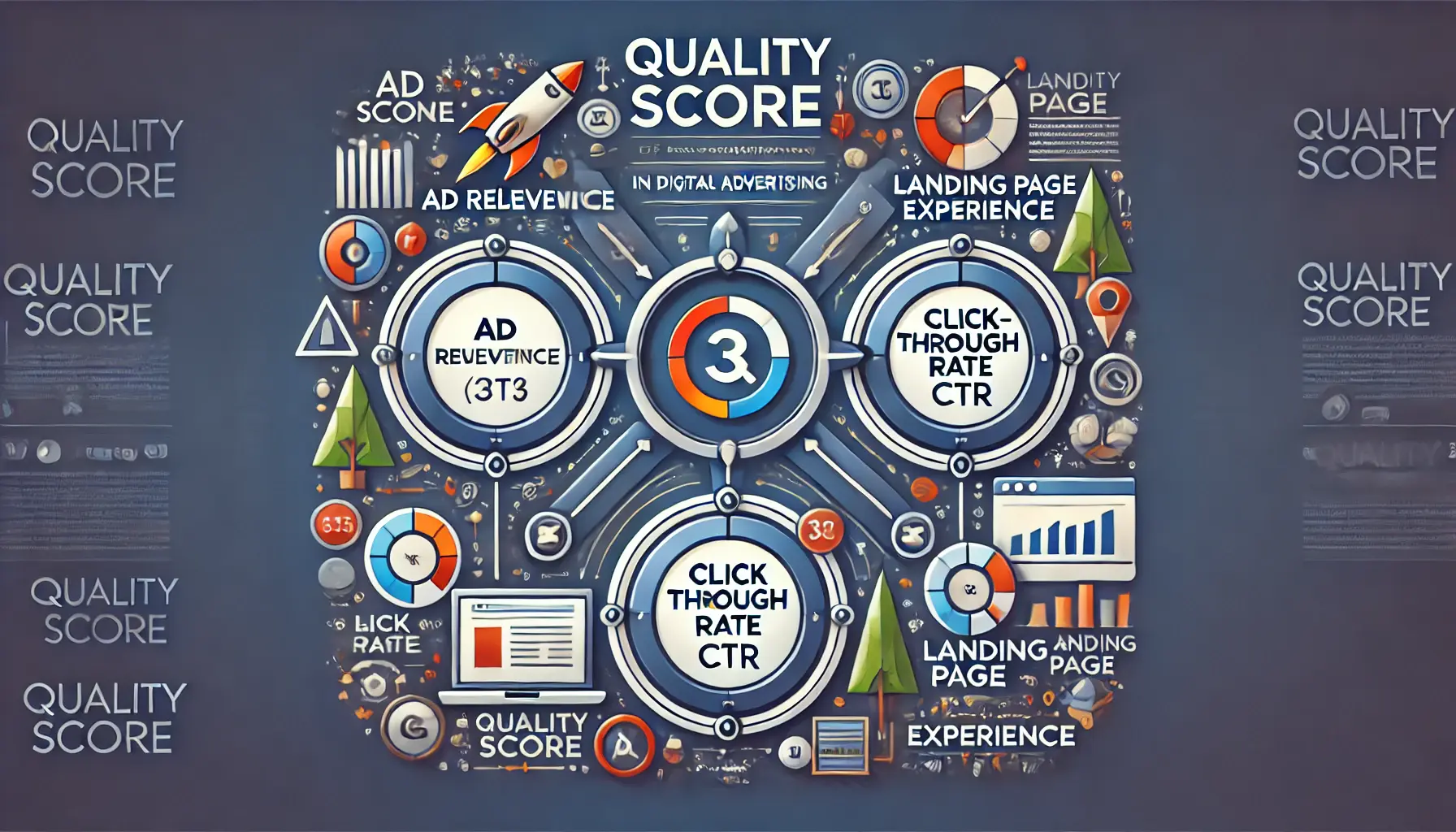
Visual representation of the main components of Quality Score.
Know the Core Components of Quality Score
Quality Score is based on three main components: ad relevance, click-through rate (CTR), and landing page experience.
Each of these factors helps Google assess the quality and relevance of your ad to users.
- Ad Relevance: Ensure that your ad copy and keywords closely align with what users are searching for, creating a connection with user intent.
- Click-Through Rate (CTR): Higher CTR indicates better engagement and relevance, which positively impacts Quality Score.
- Landing Page Experience: A well-optimized landing page provides a positive user experience by delivering accurate, transparent information that aligns with the ad’s promises.
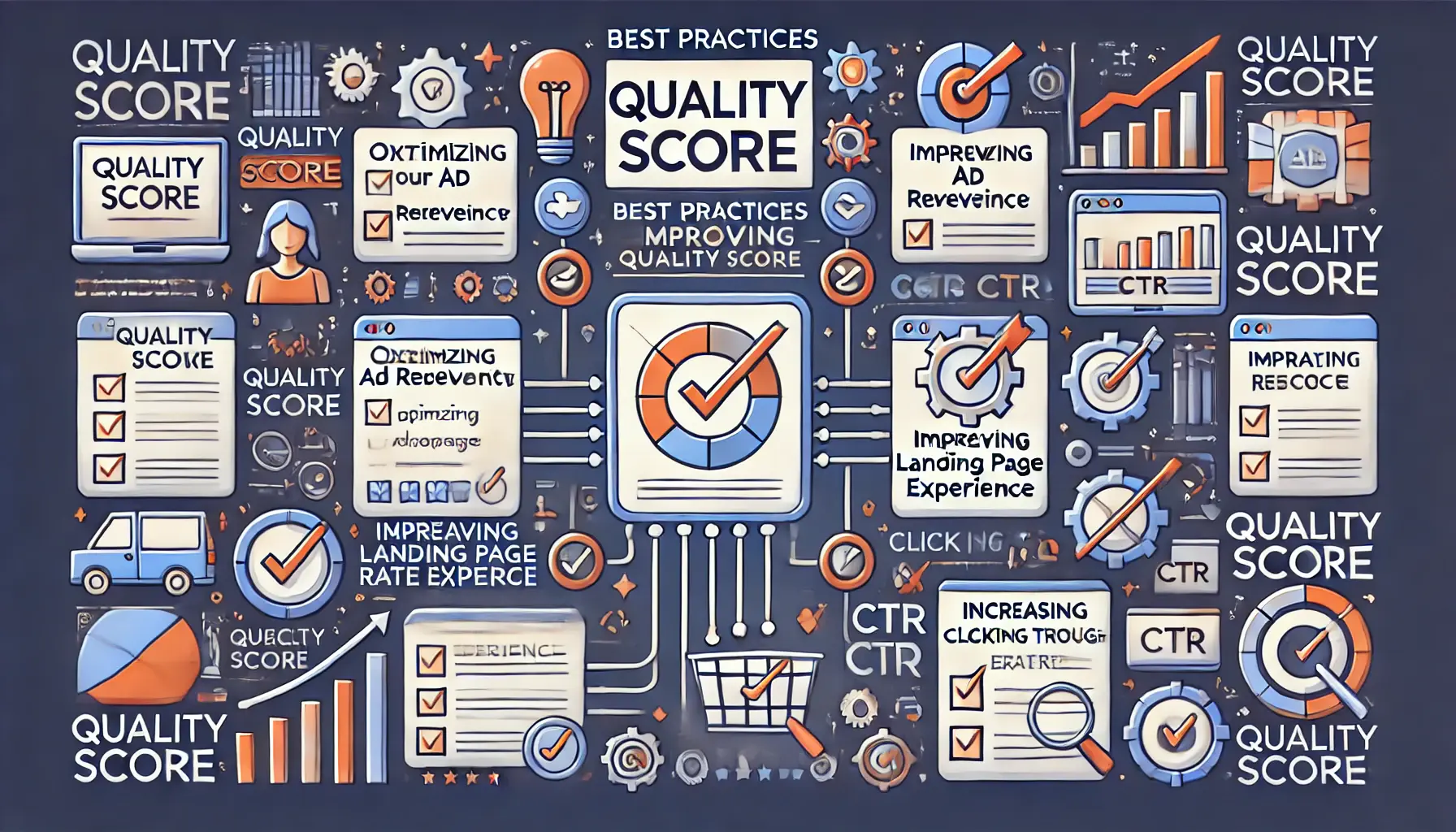
Visual representation of key strategies for enhancing Quality Score.
Best Practices for Quality Score Improvement
Applying best practices to each Quality Score component can significantly enhance your ad performance and overall Quality Score.
Here’s a quick summary of effective strategies:
- Ad Relevance: Use specific keywords and align ad content with user intent. Write ad copy that is relevant and engaging for your target audience.
- CTR Optimization: Craft engaging headlines, add ad extensions, and ensure ad relevance to user intent. A/B test different ad variations to find the best-performing versions.
- Landing Page Experience: Ensure that your landing page content matches the ad, loads quickly, and is mobile-friendly. Use clear calls-to-action and maintain consistency in messaging from the ad to the landing page.

Visual representation of measuring and tracking Quality Score over time.
Measuring and Monitoring Quality Score Over Time
Continuous monitoring and analysis are crucial for long-term Quality Score improvement.
Use Google Ads tools and reports to track Quality Score metrics over time, allowing you to make informed adjustments based on performance data.
Here are some specific actions to consider:
- Utilize Google Ads Reports: Review metrics such as CTR, ad relevance, and conversion rates to pinpoint optimization opportunities.
- Strategic Bid Adjustments: Increase bids for high-quality keywords with strong ROI, while lowering bids on keywords with low Quality Scores.
- Observe Trends and Patterns: Track Quality Score trends to identify successful strategies and replicate them across different campaigns for improved performance.
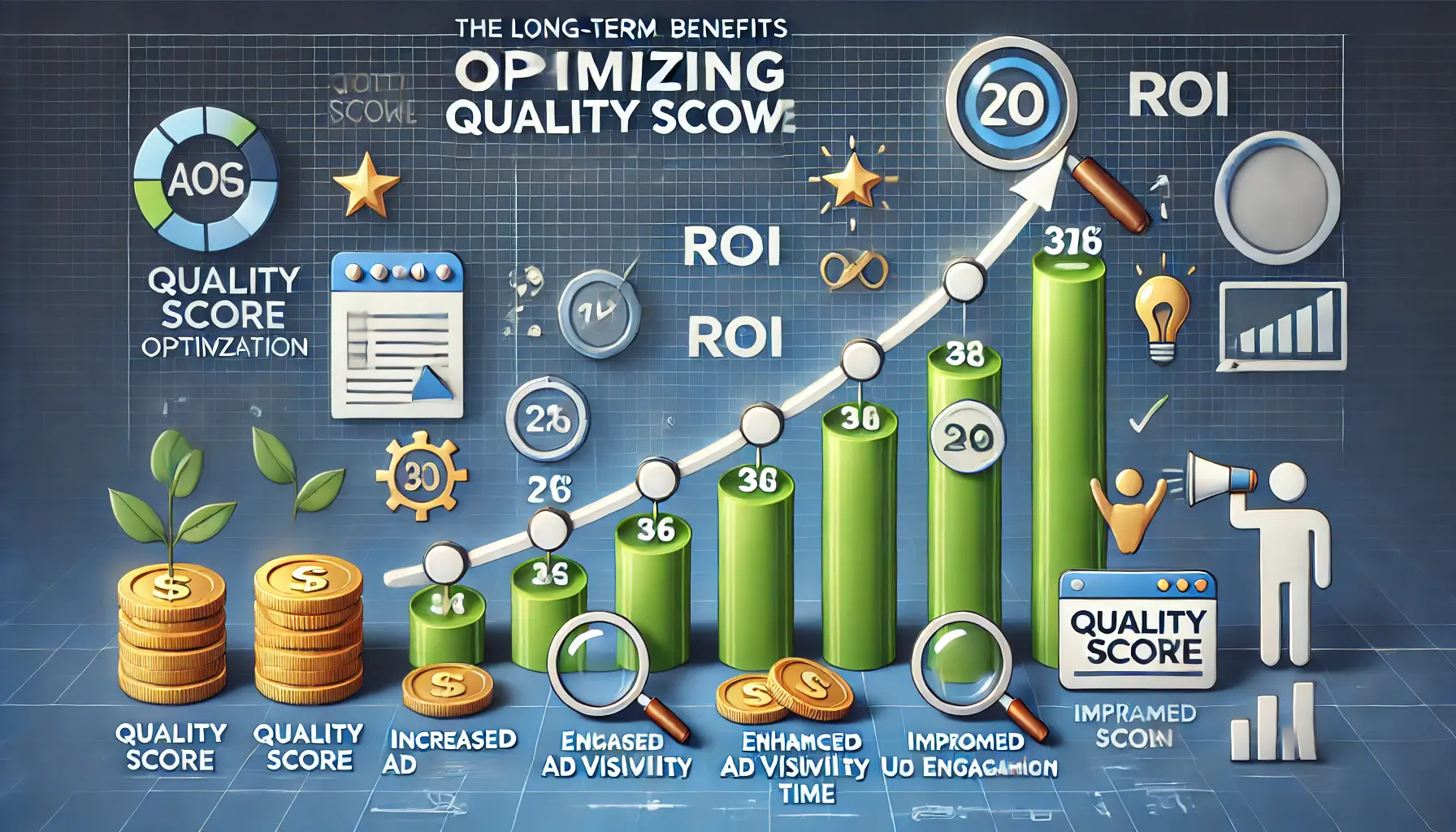
Visual representation of the long-term advantages of optimizing Quality Score.
Long-Term Benefits of Quality Score Optimization
Focusing on Quality Score improvement provides substantial long-term advantages for your Google Ads campaigns.
A high Quality Score lowers costs, improves ad placement for increased visibility, and maximizes the value of your advertising budget.
Consistently implementing best practices, testing ad elements, and refining strategies based on data insights lay a foundation for sustained growth in your advertising efforts.
A high Quality Score boosts ad performance and positions your campaigns to achieve maximum returns on investment.
In summary, improving Quality Score in Google Ads is about delivering relevant, high-quality experiences to users.
With the right tools, continuous tracking, and strategic adjustments, you can optimize your campaigns for success, achieving higher engagement, efficiency, and impact.
Focus on Quality Score’s core components—ad relevance, CTR, and landing page experience—to build an effective, cost-efficient Google Ads strategy.

Visual representation of frequently asked questions about Quality Score improvement.
Your campaigns can be managed by an agency specialized in Google Ads, check out our service page.
Questions about Quality Score Improvement in Google Ads
Below are some commonly asked questions about improving Quality Score in Google Ads, including how it affects ad performance, costs, and overall campaign success.
The general rule is that a Quality Score above 7 is considered good.
Higher scores can improve ad placement, reduce costs, and increase overall ad performance, making it beneficial to aim for scores in this range.
Higher Quality Scores typically reduce cost-per-click (CPC) by improving ad relevance.
Google rewards ads with high Quality Scores by lowering CPC, allowing advertisers to save money on each click.
Quality Score is determined by three main factors: ad relevance, click-through rate (CTR), and landing page experience.
Strengthening each of these factors can significantly increase your overall Quality Score.
Regularly monitor Quality Score, ideally on a weekly or bi-weekly basis, to quickly identify and address any areas needing improvement to maintain optimal ad performance.
A high Quality Score supports ad success but doesn’t guarantee it.
Other factors, such as budget, audience targeting, and competition, also impact ad performance, so it’s essential to optimize all elements of your campaign.
Ensure the landing page loads quickly, aligns with ad copy, and provides informative details.
A user-friendly, mobile-optimized page enhances landing page experience and helps improve Quality Score.
Yes, Quality Score impacts ad rank, which determines the frequency and position of your ads on the search results page.
Higher Quality Scores can improve ad position, making your ad more visible to potential customers.
No, Quality Score can vary by device.
Monitor Quality Score by segmenting reports by device (desktop, mobile, tablet) to optimize performance across each platform effectively.
